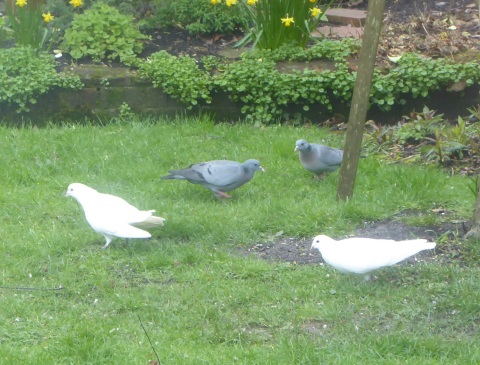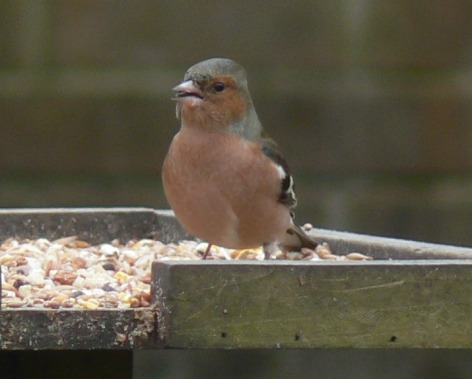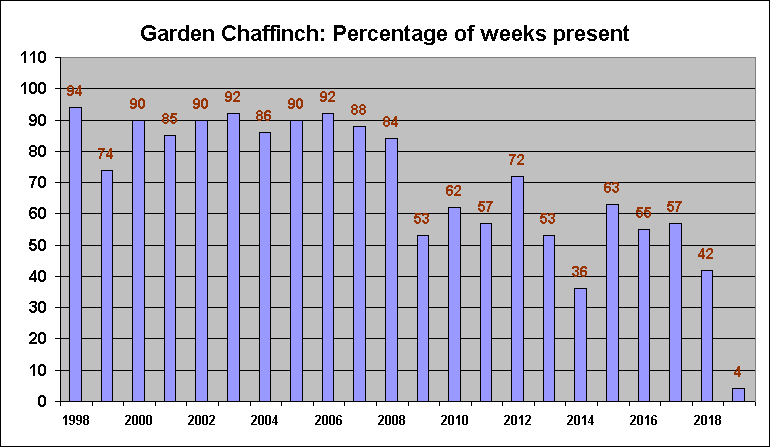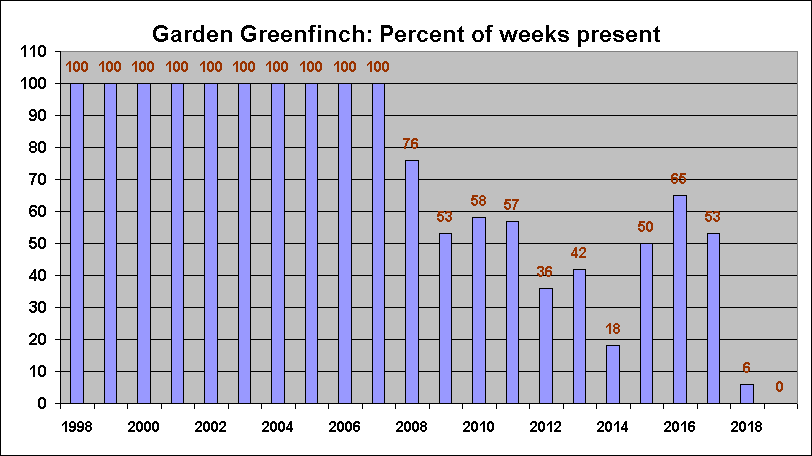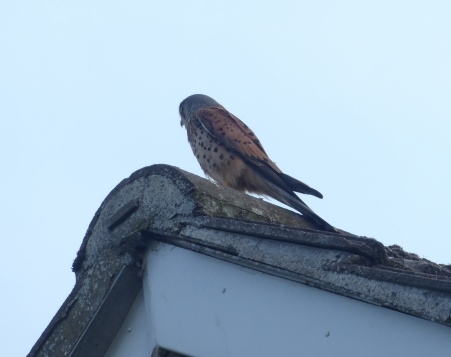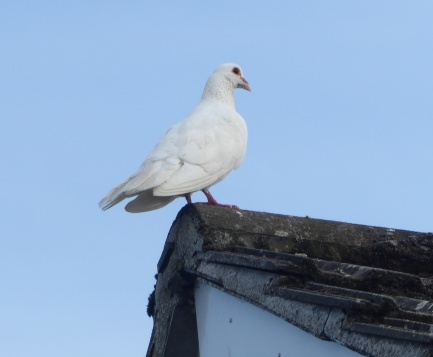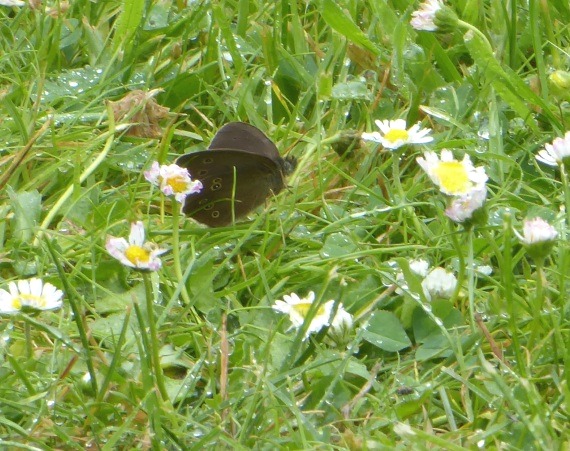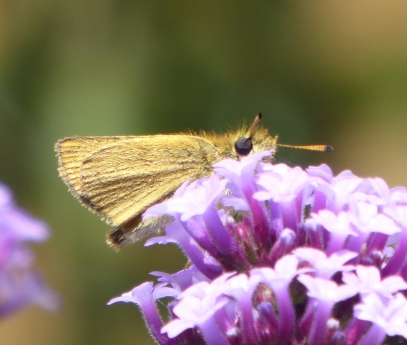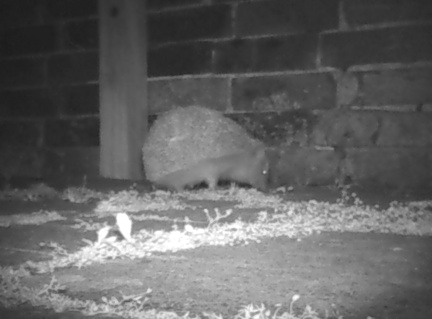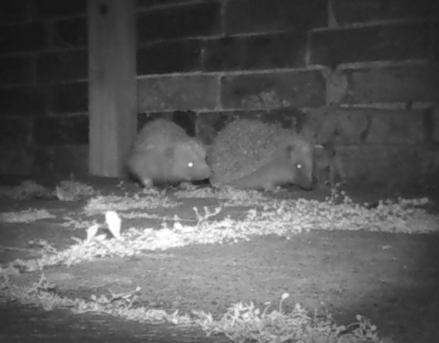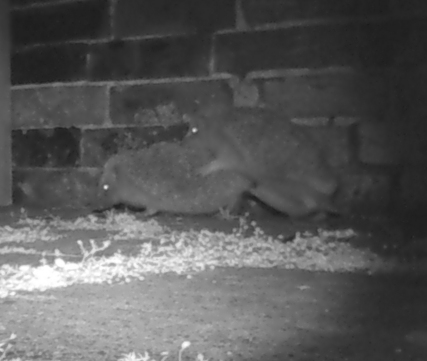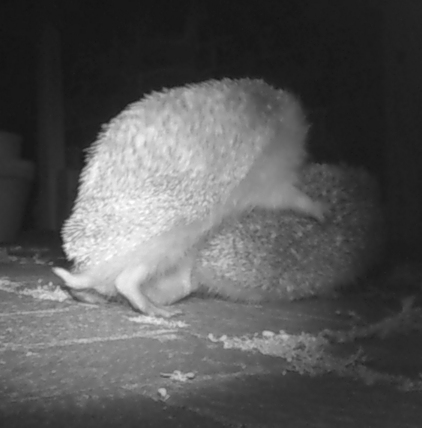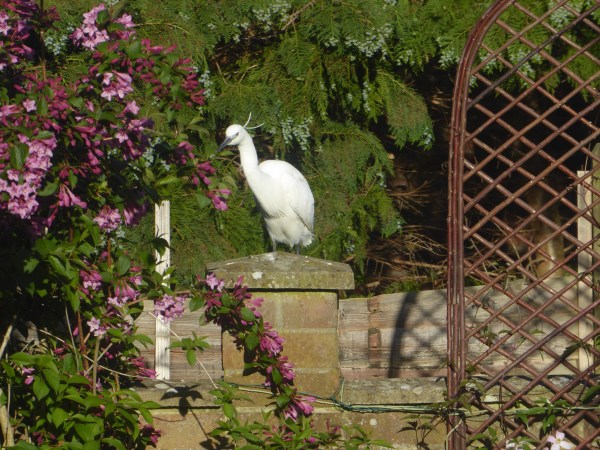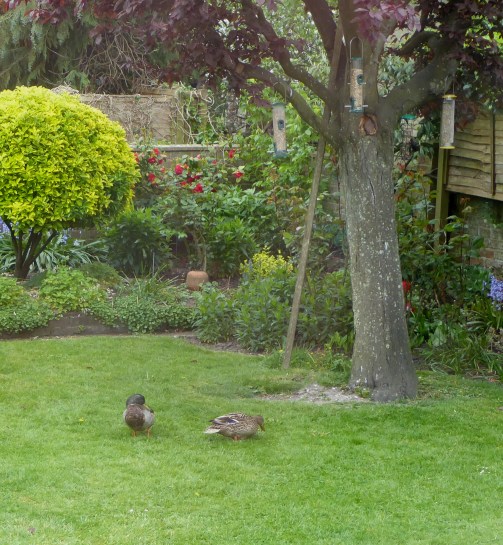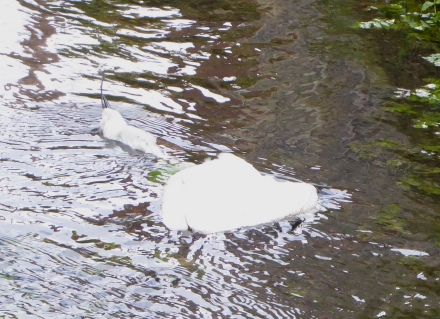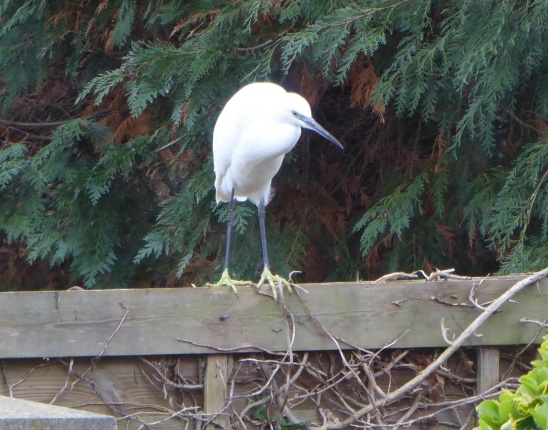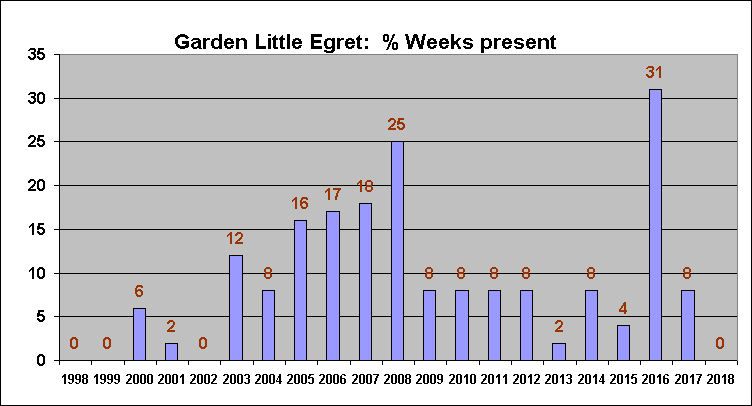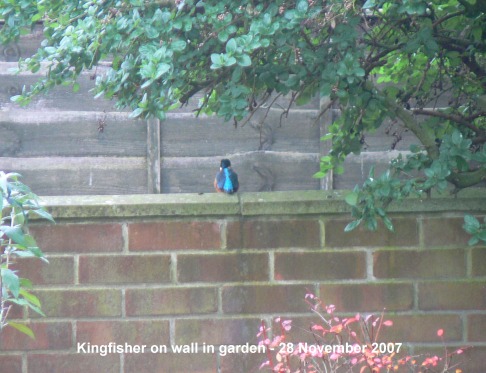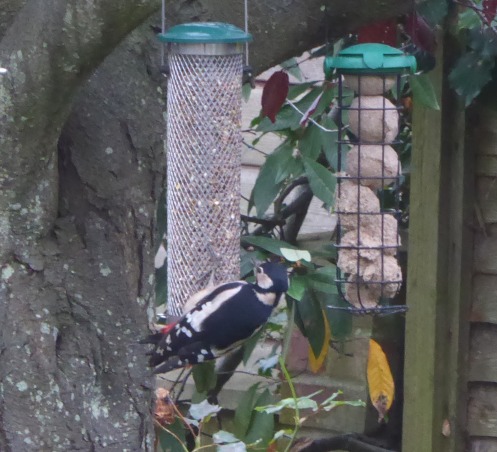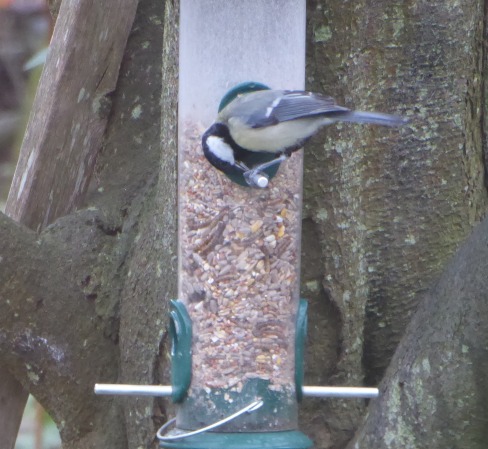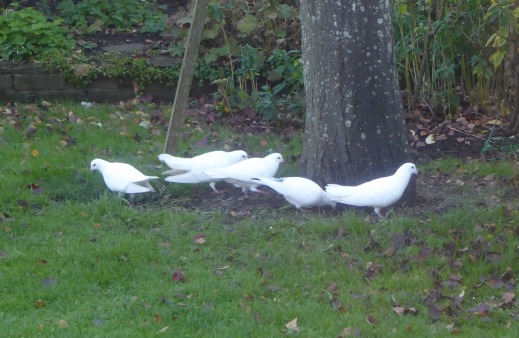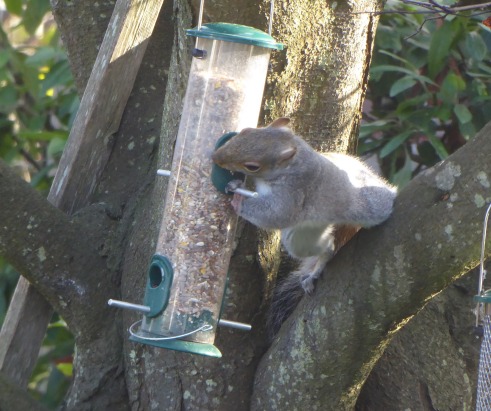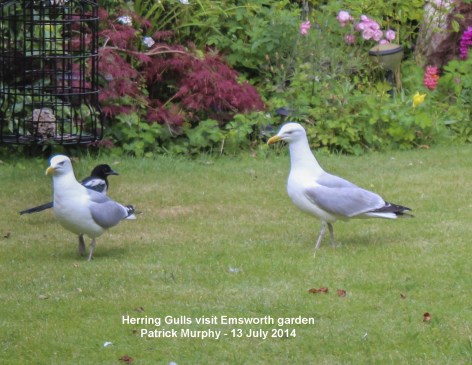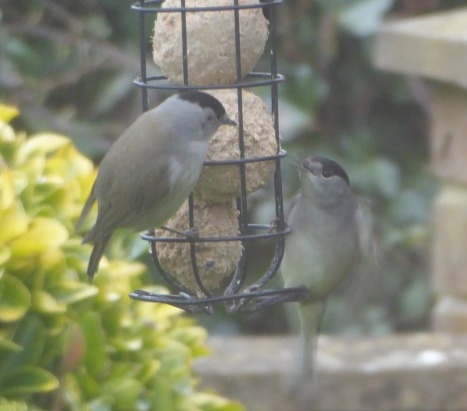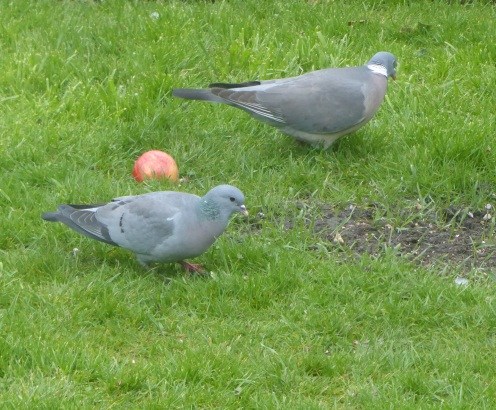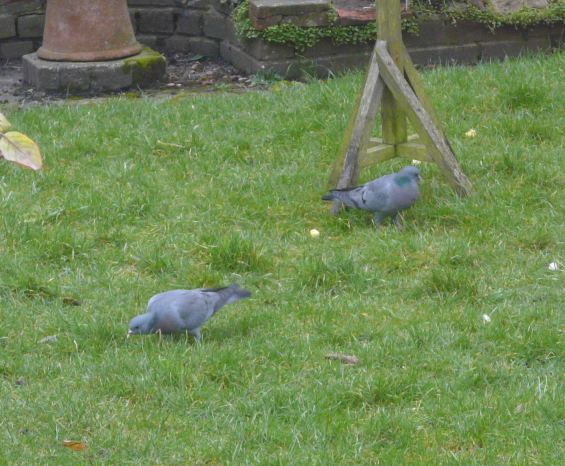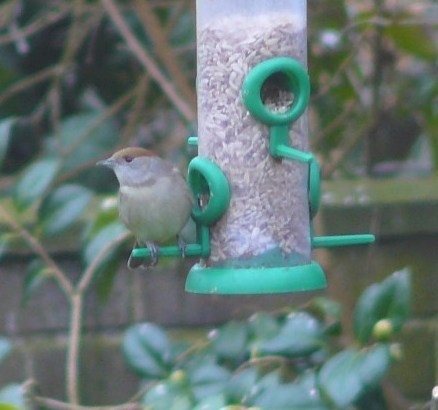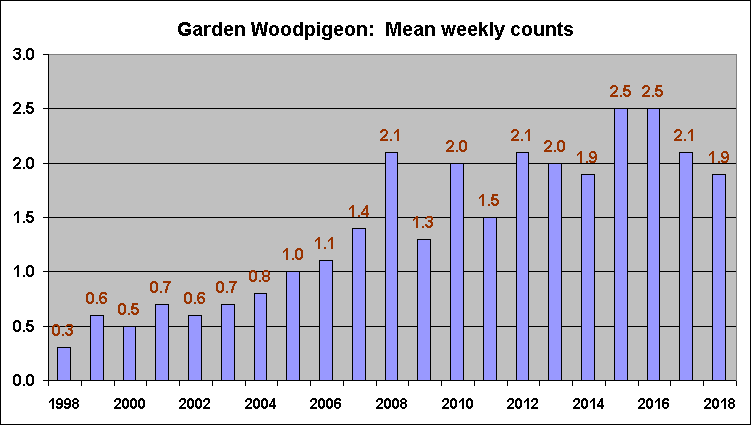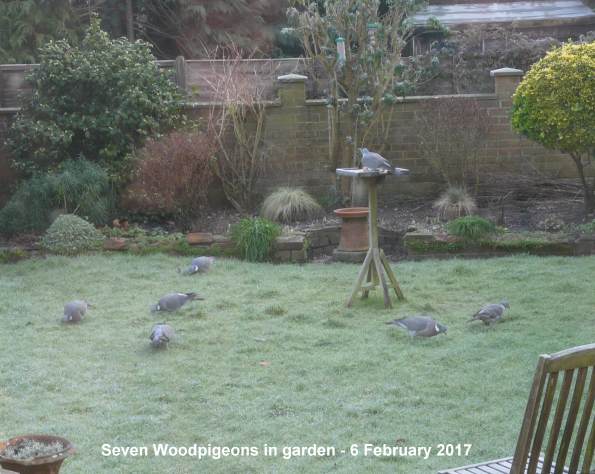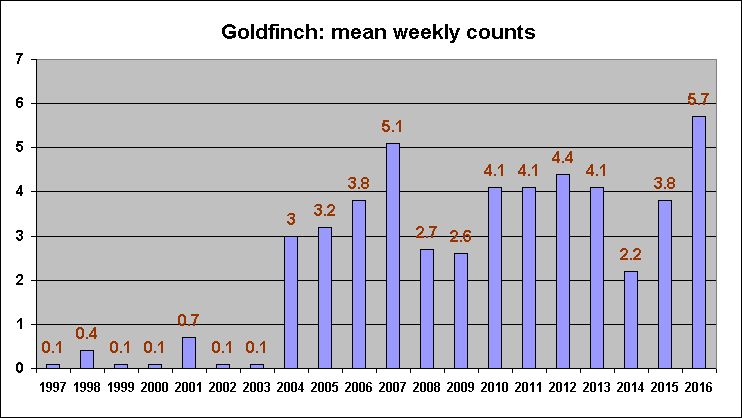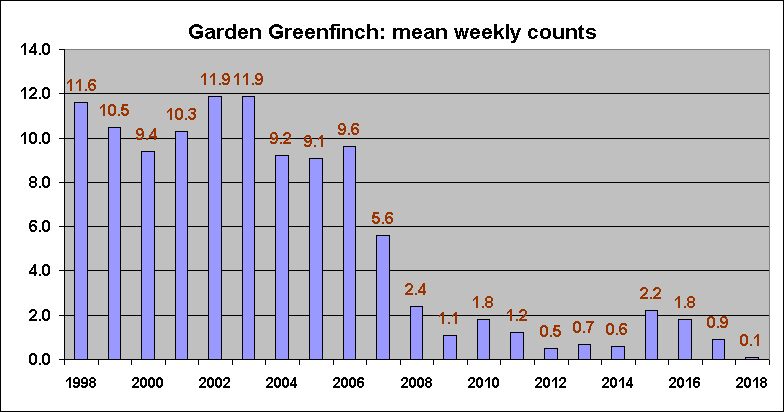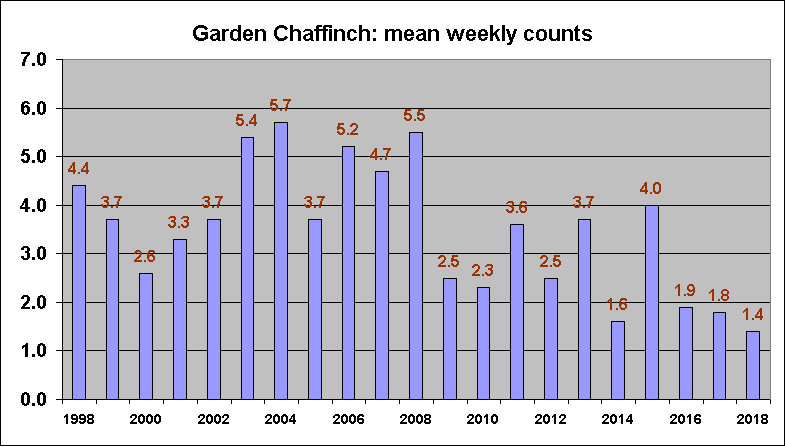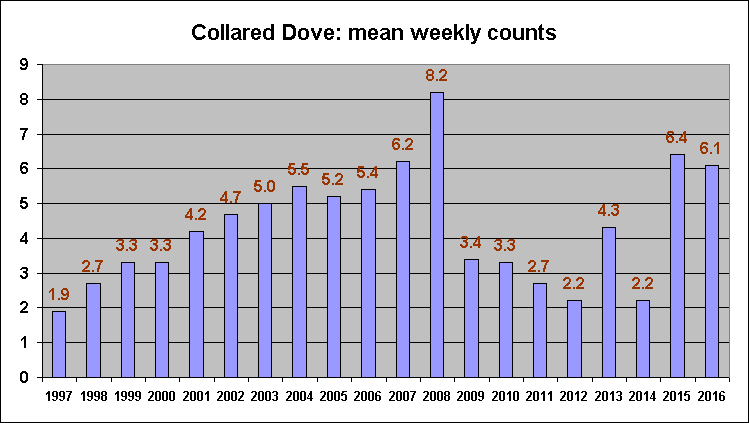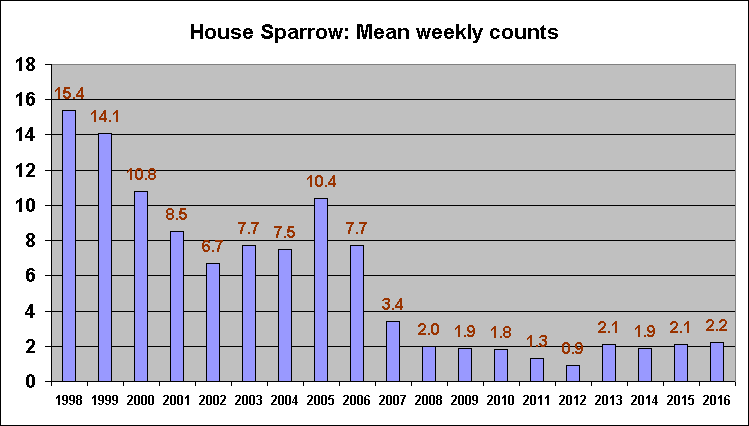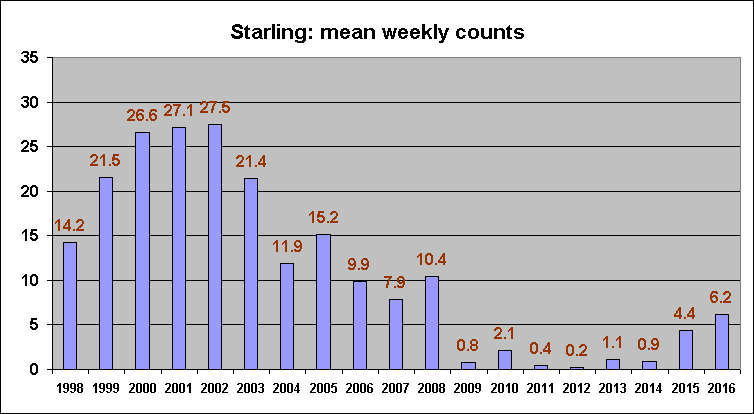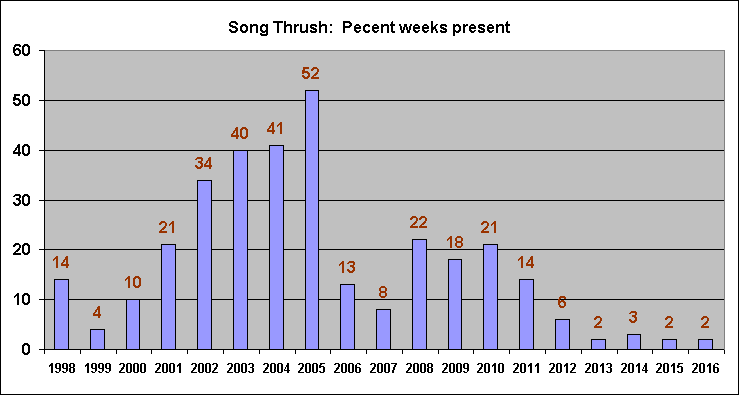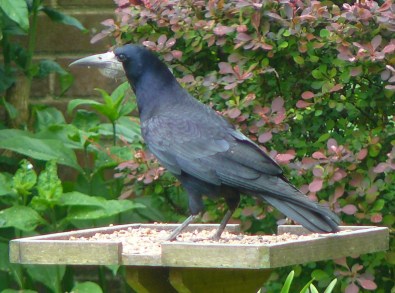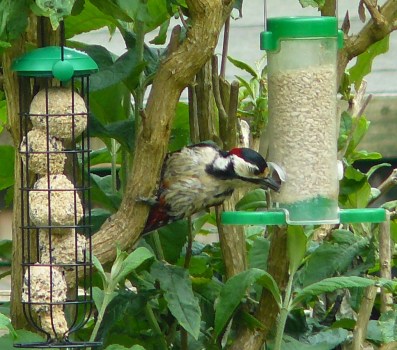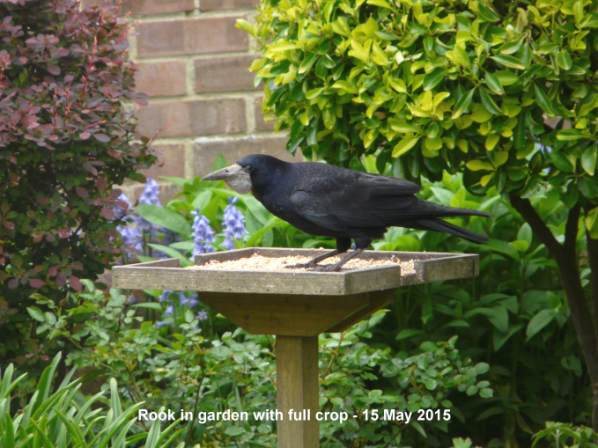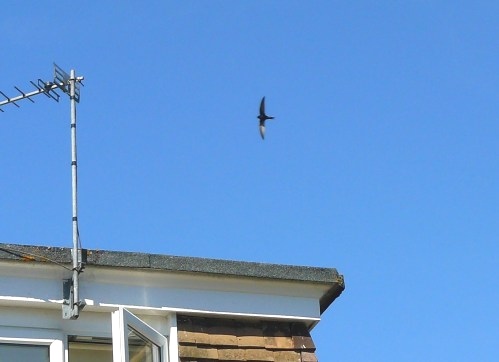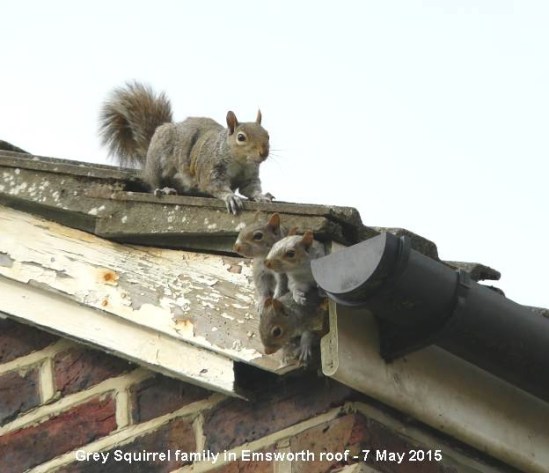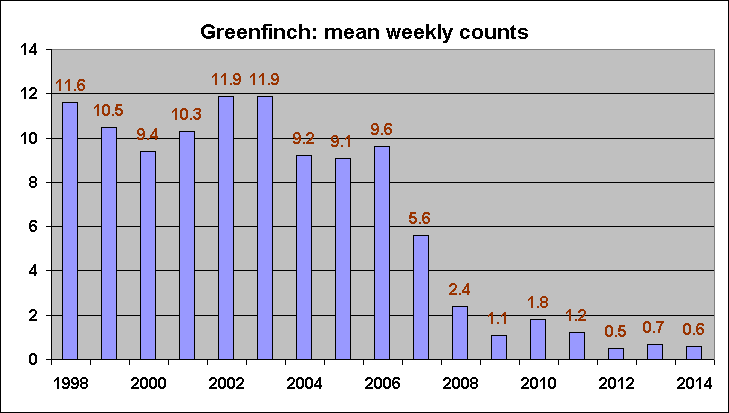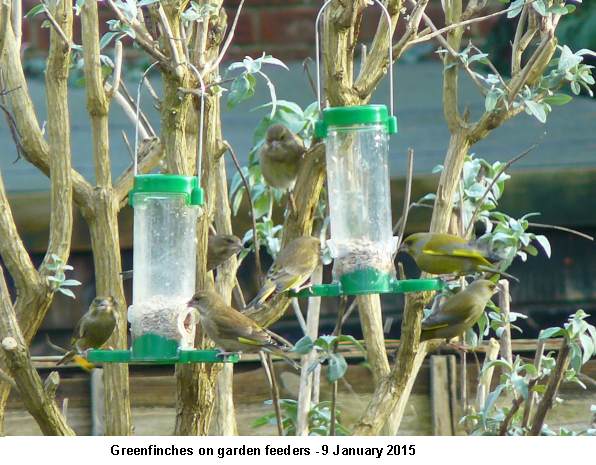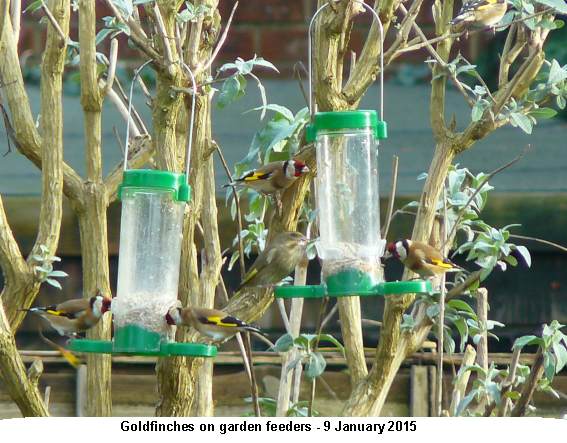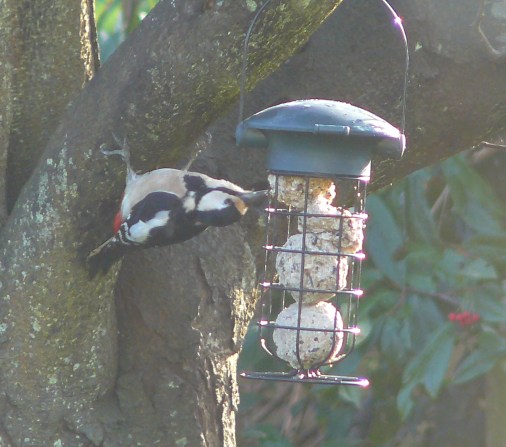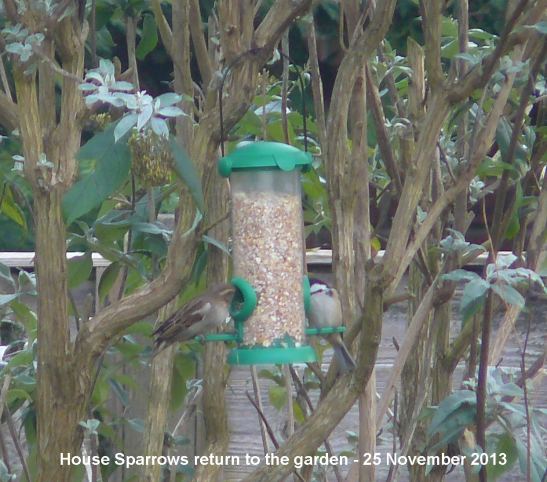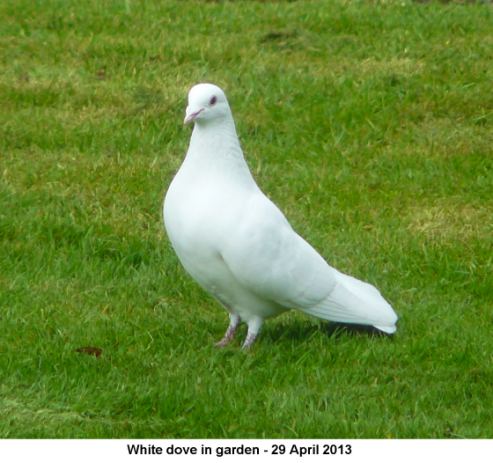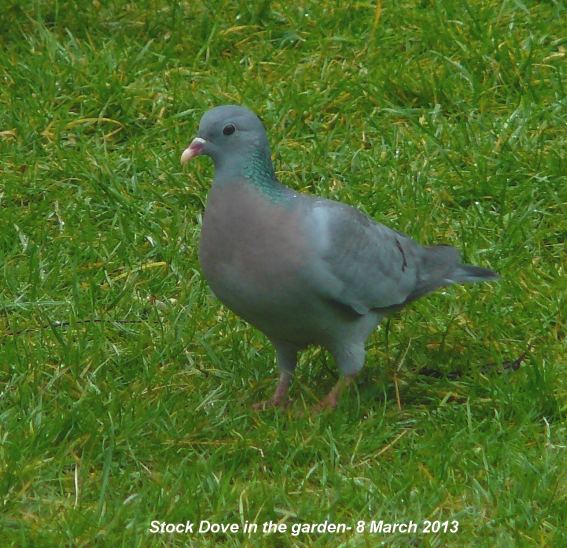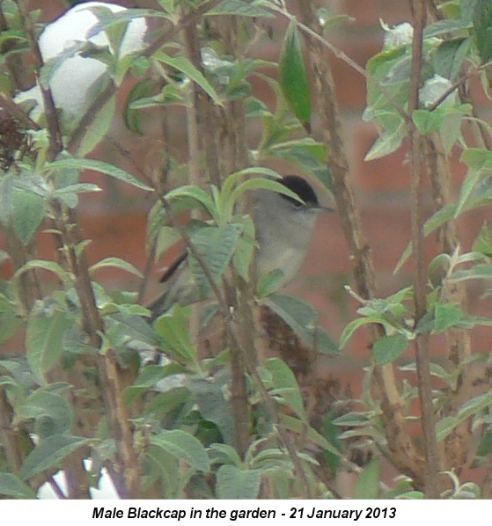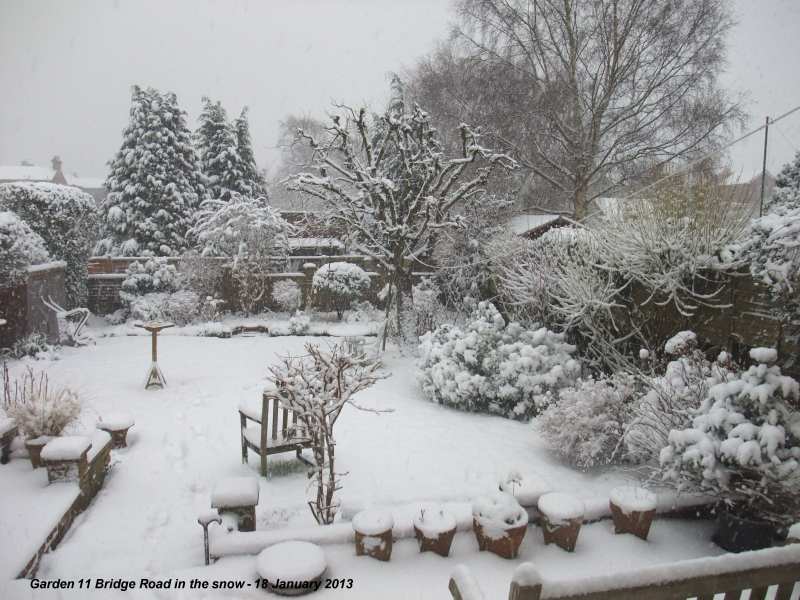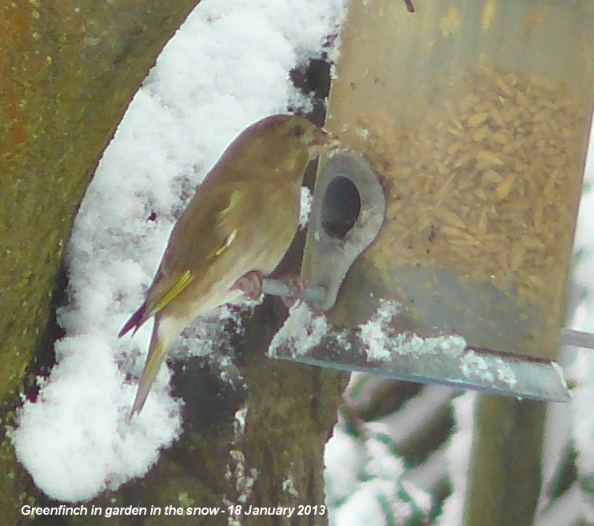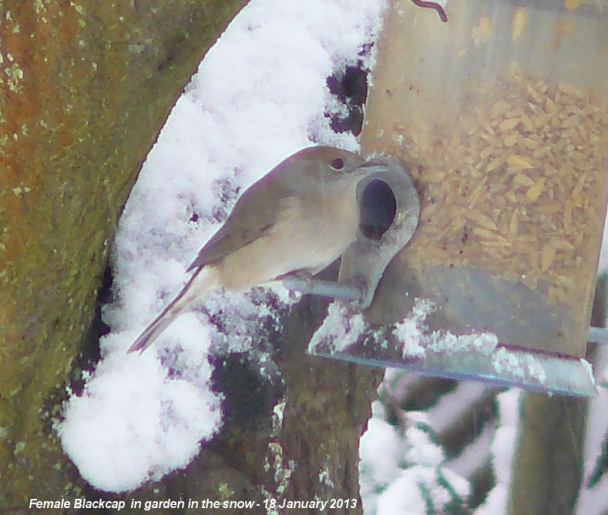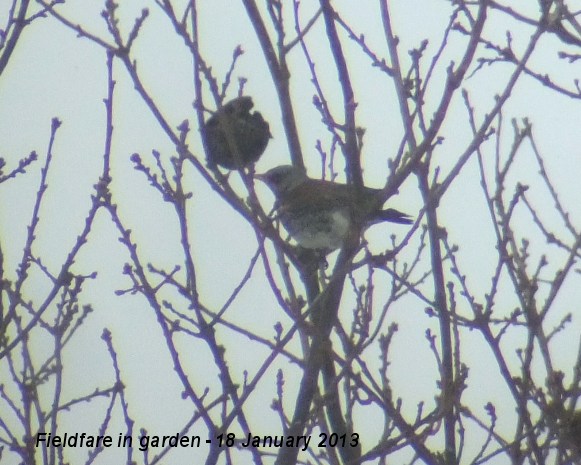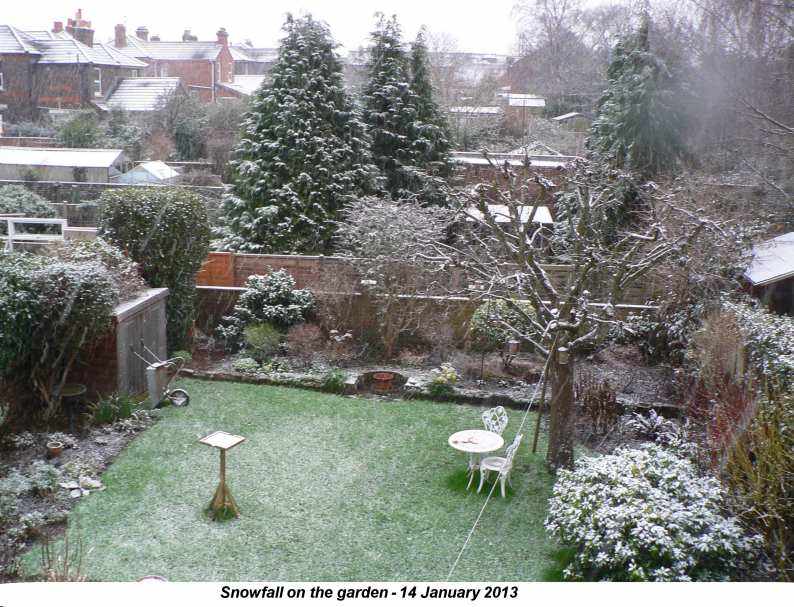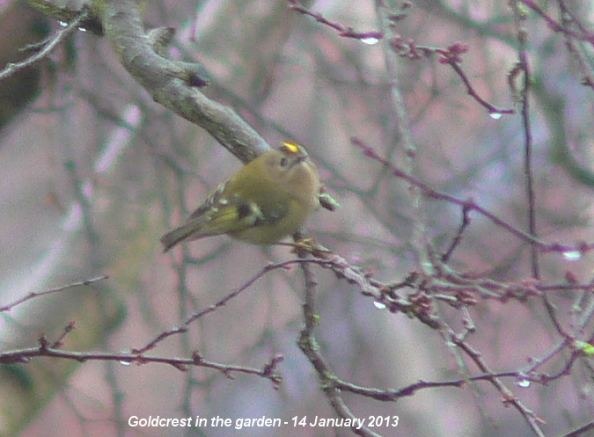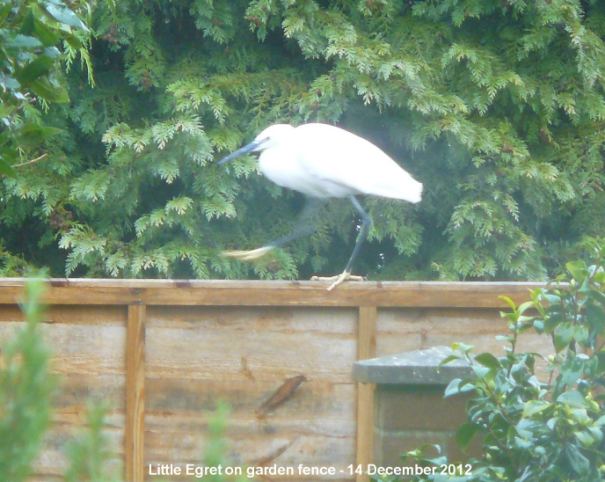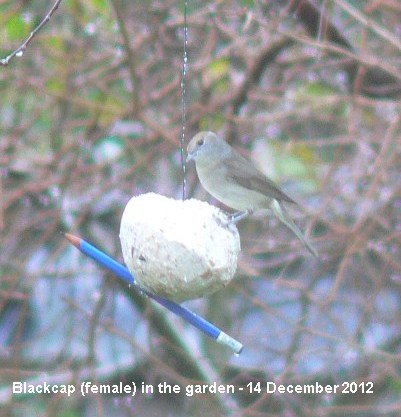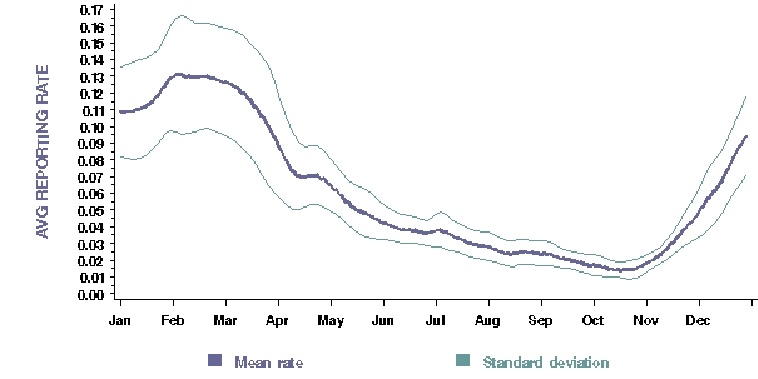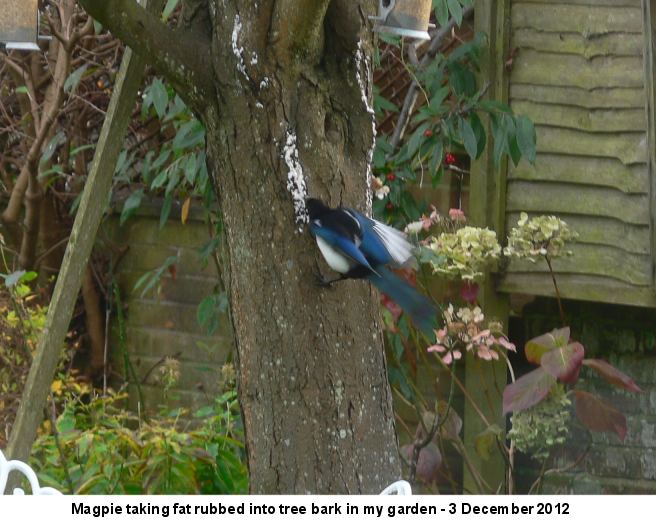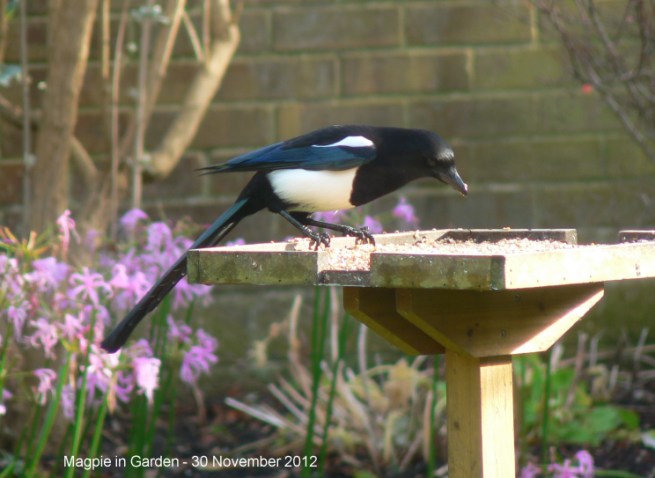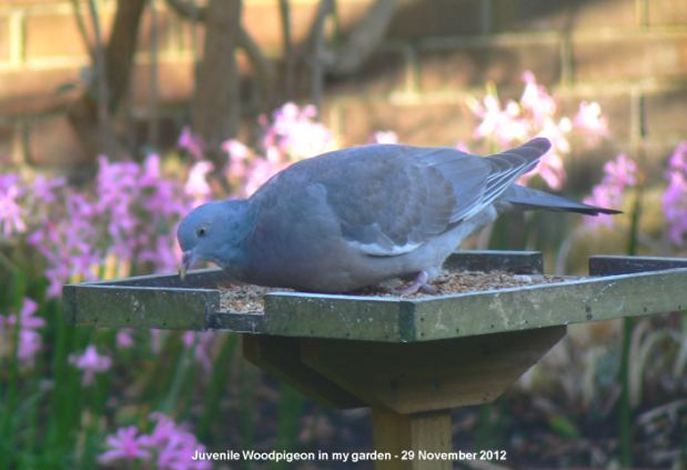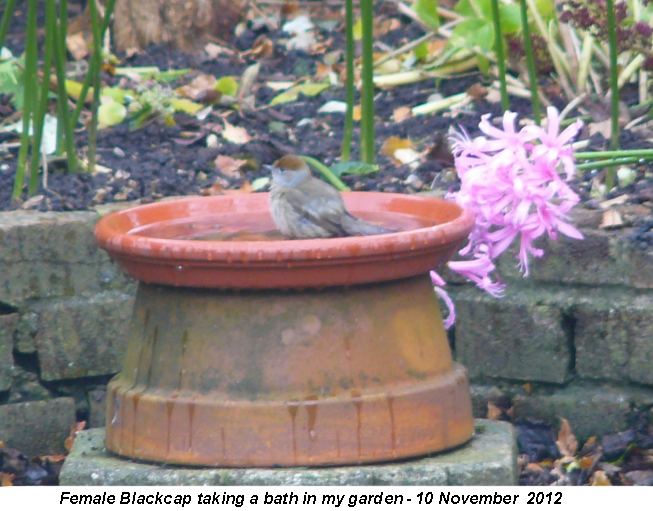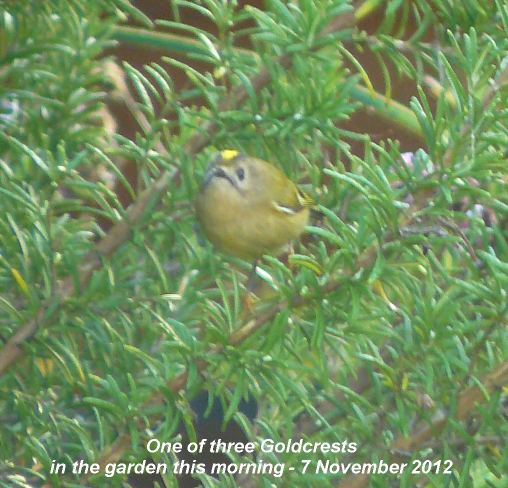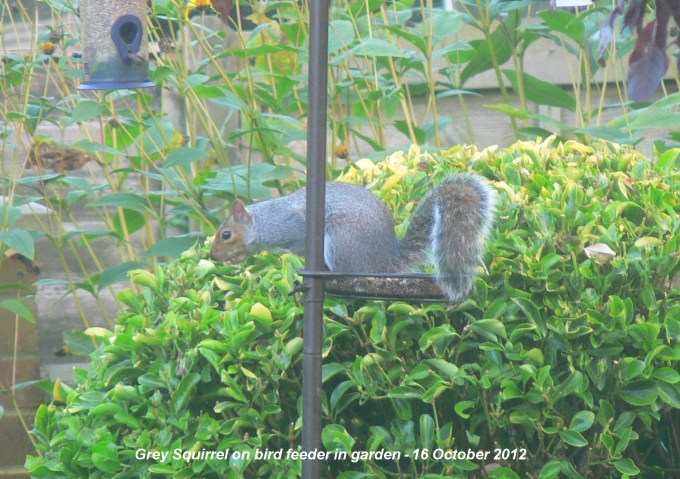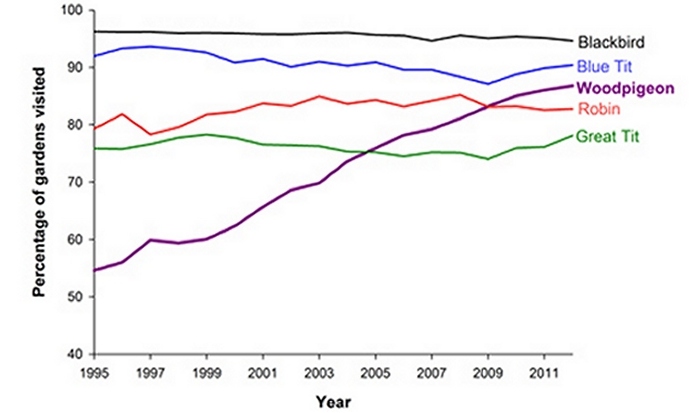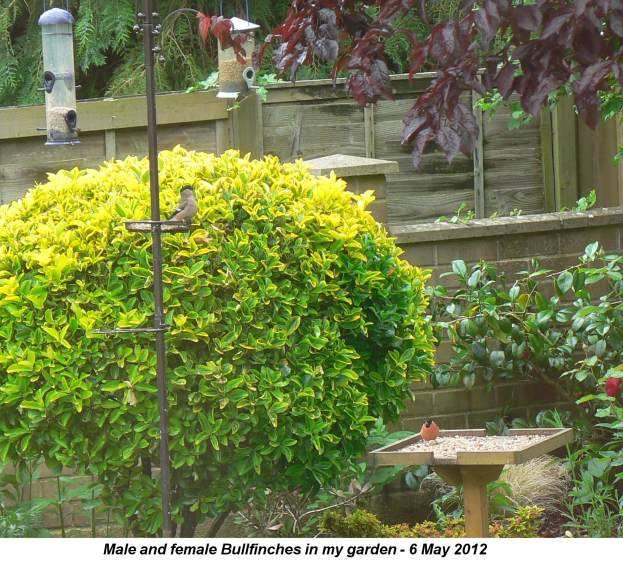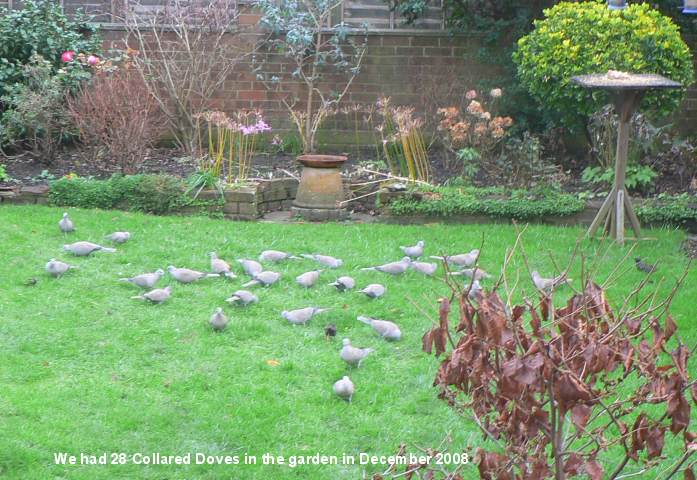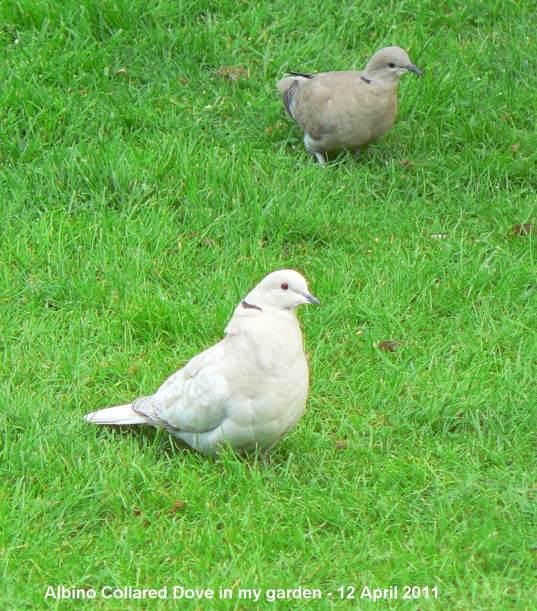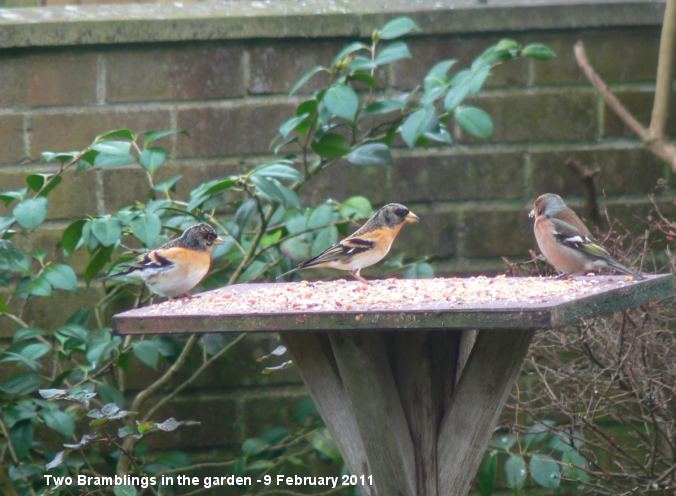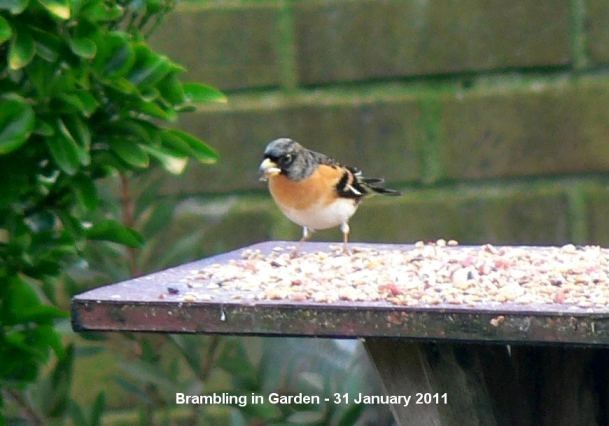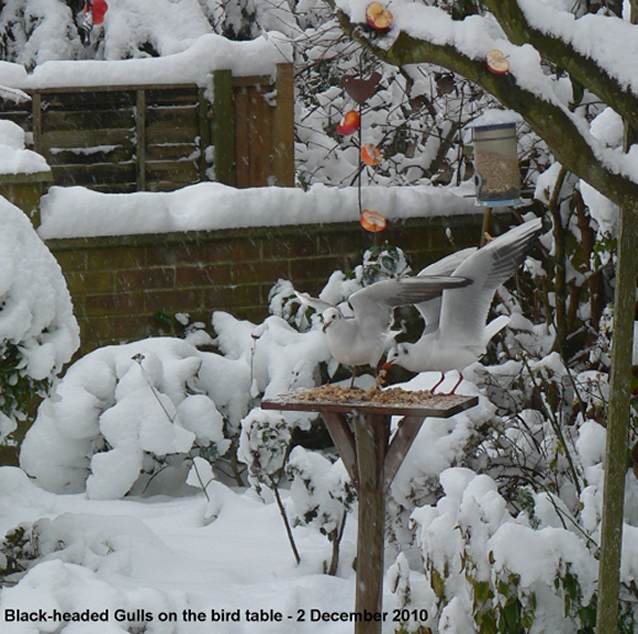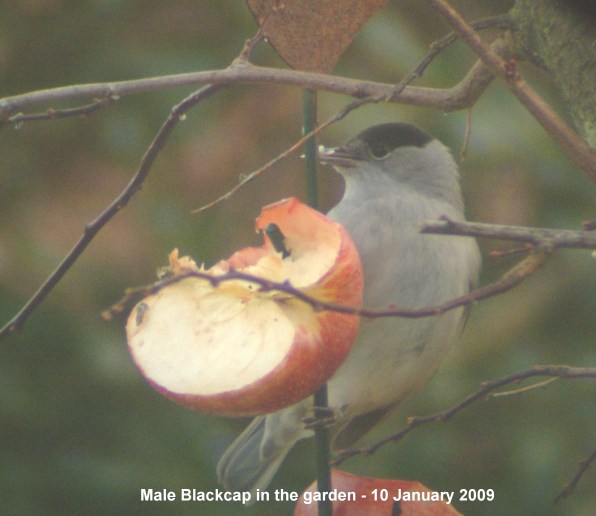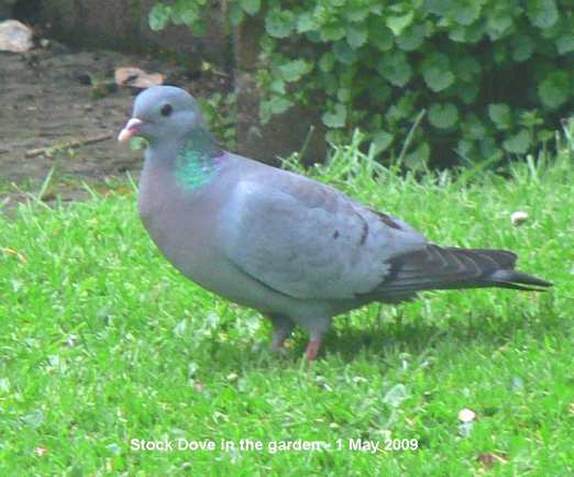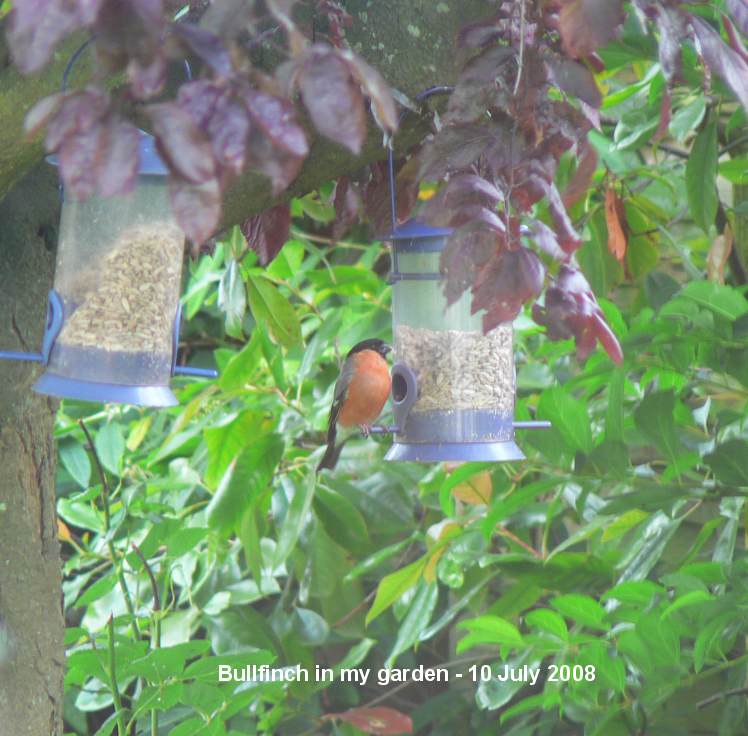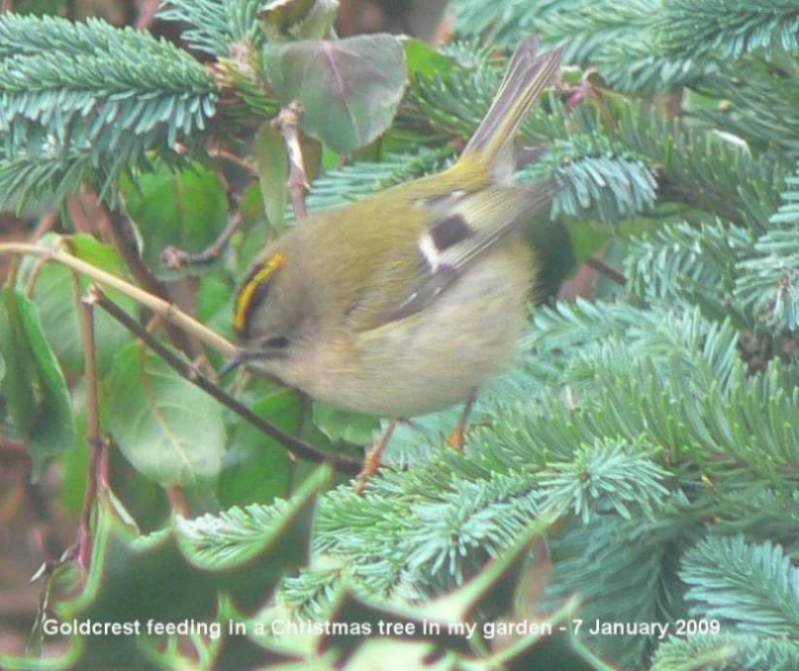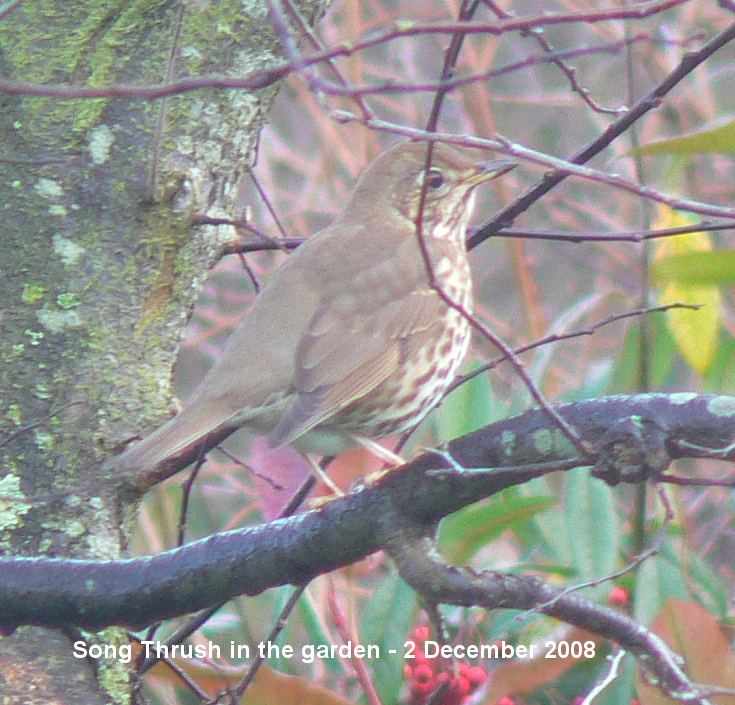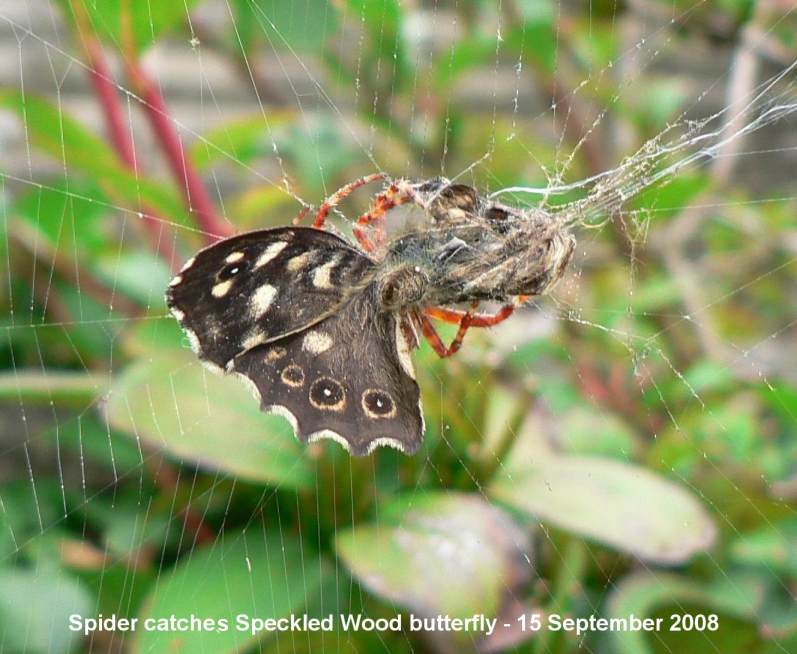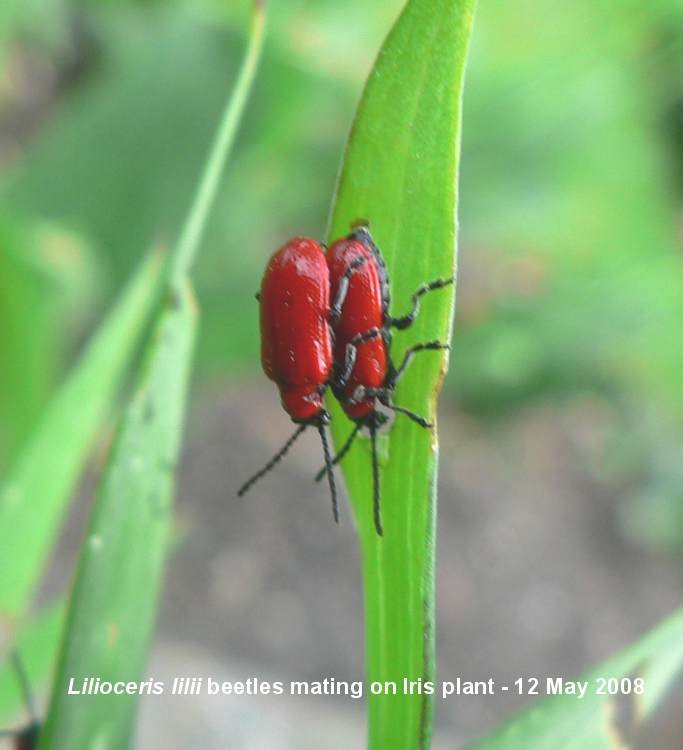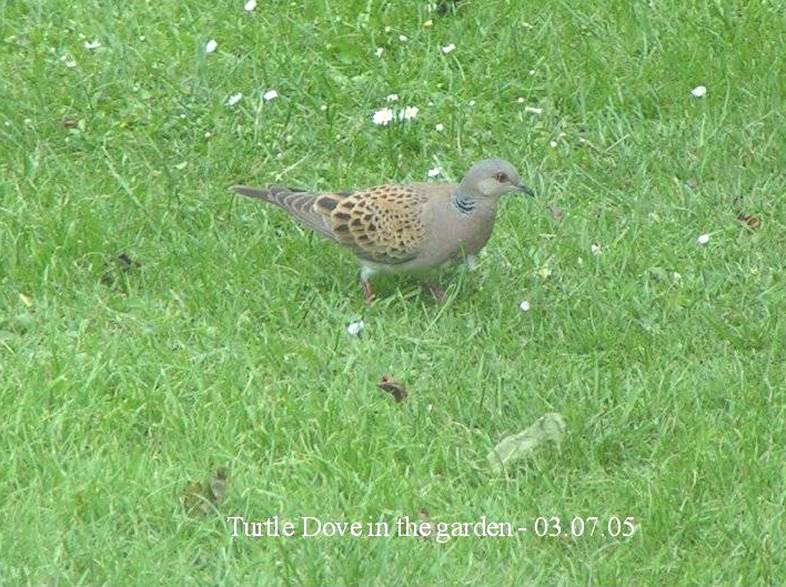RETURN TO . . . Emsworth Wildlife - Homepage . . Garden birds main page
BIRDS IN MY GARDEN
Garden highlights. . .
Tuesday 8 March - 2020
Stock Doves in garden
I was very pleased to see two Stock Doves in the garden this lunchtime. This is my first sighting of Stock Dove in the garden for a year; I had two at almost a year ago on Mar 20th. They regularly seem to turn up at this time of the year. Why is that?This year, as shown in the photo, they came in with a pair of white doves. We have had a flock of white doves in Emsworth for the last couple of years, there used to be about 10, but I think there are just two left. Apparently, they were released at a wedding in St James Church and were not recaptured and have been hanging around the church, coming into local gardens to glean droppings from the bird feeders.
Video clip of the Stock Doves in the garden . . . https://youtu.be/AOBMRPHb8xs
SUNDAY March 8 - 2020Chaffinch in Garden!
Yesterday, I was astonished to see a Chaffinch (male) in the garden for the first time for a whole year! He did not stay long enough for a photo, so here's one I got a few years ago, just in case you can't recall what they look like!
SUNDAY FEBRUARY 23 - 2020Chaffinch demise!
The British Trust for Ornithology has published its latest assessment of the size of bird populations in the UK. Wren continues to hold the title of our commonest breeding bird with 11,000,000 pairs, followed by Robin (7,350,000 pairs), House Sparrow (5,300,000), and Woodpigeon (5,150,000). Chaffinch and Blackbird share the number five spot at 5,050,000 territories each. Turtle Dove numbers have dived from 75,000 pairs in 1997 to just 3,600 pairs.
But most alarming is the decline in the Chaffinch breeding population which has fallen by 1.15 million pairs since the last report seven years ago. They say the reasons for this decline are unclear and need further investigation. See . . . https://bto-enews.org/IG4-6QCS6-3RN36S-3Y4KPA-0/c.aspxThis shocking news of the Chaffinch decline comes as no surprise to garden birdwatchers like myself. Chaffinch sightings in my Emsworth garden have fallen dramatically since about 2008 as the following chart shows. The largest Chaffinch collapse was last year when I saw a Chaffinch on only two weeks in the year - in early March 2019. I shall keep my eyes skinned for any repeat performance this year.
Greenfinch has undergone an even more dramatic decline as shown in the following chart. Greenfinch was until 2007 the number one bird in my garden with a 100% turn out throughout the year. However, in 2008 the disease trichomonosis decimated the Greenfinch population with a dramatic effect on garden sightings to the point last year when I went the whole year without seeing a single one in the garden. Unbelievable!
SATURDAY JULY 13 - 2019
Hedgehogs
My trail camera picked up two Hedgehogs as usual visiting the garden last night. Here is a nice shot of one of them clearly enjoying a good drink from the tray of water I always leave out for them. Go to . . . https://youtu.be/jeTkVHL1VDY
THURSDAY JULY 11 - 2019
Kestrel in garden
Jean and I were having our evening meal outside on the patio at about 6.30 when the flock of White Doves that mop up the fallen seeds under the feeding station suddenly took off in a flurry of wings. I looked up and spotted the perpetrator of the commotion perched on the apex of my neighbour's roof. I could not see it too well against the light sky, but assumed it was a Sparrowhawk, and probably a female from its small size. The bird stayed on the roof just long enough for me to get a couple of shots of it with my camera before it flew off. It was not until I looked at the images on my PC that I realised with Sparrowhawk was in fact a male Kestrel. This was the first Kestrel I have ever recorded in my present garden over the past 22 years. Sparrowhawk is a fairly common garden visitor, but Kestrel is quite rare.A few minutes later the White Doves returned and ironically one of them perched on the roof in exactly the same spot as the Kestrel a few minutes before! The Kestrel would have been welcome to a White Dove, though its size would make it a difficult catch. I reckon a female Sparrowhawk could take one.
Hedgehogs
The trail camera picked up visits from both the regular male Hedgehogs that I am now able to identify individually. The hog with a bad limp on its back legs that I call 'Limpy' arrived first to clean up the few mealworms I sprinkle in front of the camera.See video clip of Limpy last night . . . https://youtu.be/IIBA2-LoH6U
The hog that moves well without a limp and regularly pushes Limpy around when they are both on camera I call 'Bossy'. Bossy arrived in early morning and was caught on camera passing close to a cat which took little notice of it. My trail camera gives a fascinating, if limited, insight into some of the activities that take place when we are all asleep.
See video clip of Bossy with the cat last night . . . https://youtu.be/fCqLob2tbC0
SUNDAY JULY 7 - 2019
Garden butterflies
After the rain stopped this morning I spotted a brown butterfly fluttering low over the lawn in the back garden. Meadow Brown? No, a closer look when the insect rested on the ground, revealed a handsome Ringlet. I managed to get a quick snap before it took off. Following the Essex Skipper just four days ago, this was another first for the garden! Two garden rarities in the space of a week. What next?Regarding the Essex Skipper, I had an e-mail from Bob Marchant to say he was reading about the Cattle Egrets nesting at Langstone Mill Pond in my blog when he noticed the post regarding Essex Skipper. Bob also had an Essex Skipper in his Locks Heath garden - also a first for him! He wonders if there has been an influx of them?
I have not seen a Essex Skipper anywhere else this year, though Ringlets are certainly having a good year on Brook Meadow where they are flying in good numbers along with the slightly paler Meadow Browns.
THURSDAY JULY 4 - 2019
Swifts
May people have been reporting Swifts flying in the local area, usually ones, twos or threes. We had four flying low over our house in Bridge Road this morning which is the most we have seen this year. So good to see after many barren years with hardly anything. Just think 20 years ago we had up to 20 Swifts screaming around the houses in Bridge Road. My son, who lives in Cowes on the Isle of Wight, tells me he regularly sees up to 30 Swifts flying around the houses in his area. Lucky chap!
Essex Skipper in garden
I was surprised and delighted to see what looked like a Small Skipper feeding on the Perennial Verbena flowers in the garden this afternoon. This would be a garden first. However, when I saw the jet black tips to the insect's antennae ('as if dipped in ink') I immediately thought of the much rarer Essex Skipper. I have nothing else to go on but for the black antennae tips, but I am sticking to it as a unique garden sighting.
TUESDAY JULY 2 - 2019
Hedgehogs
My trail camera picked up a pair of Hedgehogs in the garden last night, circling around and snuffling in their usual fashion.
See video clip at . . . https://youtu.be/gFKNF53kUK8The female (with no penis!) was back in early morning to pick up any remains of mealworms.
See video clip at . . . https://youtu.be/GDCgvEGTxAc
MONDAY JUNE 23 - 2019
Hedgehogs in gardenThe trail camera (which I had on the video setting) picked up two Hedgehogs in the garden last night taking more than a passing interest in one another! The male, which has a slight limp, spent most of an hour or so (from 22.12 to 23.36) circling around the female who appeared to be keeping her rear end away from him. At one point the male appeared to mount the female, though the picture is unclear.
Two Hedgehogs in garden 'sniffing' . . . https://youtu.be/9JiQtWlZHq8
The male circling the female . . . https://youtu.be/bxU-UQ1498c
Hedgehogs mating? . . . https://youtu.be/suf-oCpsxfY
TUESDAY MAY 14 - 2019
Hedgehogs mating in garden
Having seen what looked like Hedgehog droppings on the patio over the past few days, I decided to put the trail camera out last night along with a few mealworms to see what I could catch. Well, it was a great success. By the morning the mealworms had gone and there were no less than 192 images on the camera! I have never had this many in one night before.
The first Hedgehog arrived at 22.43 and stayed for about 10 mins. Two Hedgehogs turned up at 23.10 and proceeded to hang around for the next couple of hours until 01.40.
What I assume was the male spent a considerable time sniffing around the female and mounted on her back on several occasions. They came close to the camera in the encounter shown on the right and actually knocked the camera sideways.
I gather the actual process of mating is a delicate operation requiring the female to adopt a special body position with her spines flattened as the male mounts from behind. Radio tracking show that both males and females often have several mates in a single season.
THURSDAY APRIL 25 - 2019
Garden Egret
The Little Egret was back on the wall at the end of the garden for the second day running. This time I was ready for it with my camera at the ready. I got a rather nice zoomed photo of it through the window with its plumes blowing in the wind. To think about 20 years ago I went to Spain hoping to see a Little Egret; now I have one in my back garden. How times have changed!A pair of Mallard are also regular visitors to the garden, having come over the wall from the stream at the end of the garden. They are quite fun to have in the garden; sometimes two males turn up in pursuit of the female. They also do a good job of cleaning up seeds dropped from the holders hanging on the cherry tree.
SUNDAY JANUARY 27 - 2019
Dead Little Egret
Looking over the back garden wall this morning I was saddened to see a Little Egret lying dead in the shallow water of the stream. A Little Egret has been a regular visitor to our garden for several years as it perched on the wall or the fence at the end of the garden looking for small fish in the stream that flows down to the town millpond. If, as I assume, this dead bird is actually our regular visitor, then I shall miss its visits, though maybe another of its species will in time discover this rich feeding area and grace us with its presence.A view looking north up the Westbrook Stream from my garden wall
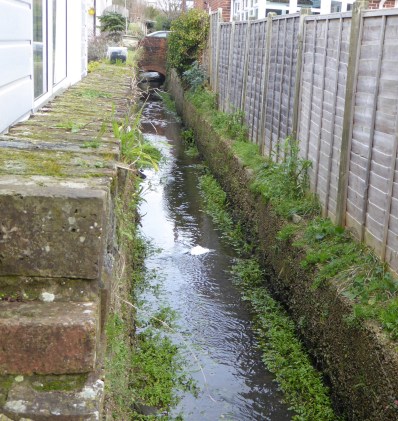
Close-up of the dead Little Egret
I don't recall having seen a dead Little Egret anywhere else before. I wonder how this one died. Natural causes is likely, though these birds have quite a long lifespan; the maximum recorded age for a Little Egret in the wild is 22.3 years. Alternatively, it could have been killed though that seems unlikely in this residential area. Large water birds are more vulnerable in open public spaces, Swans and Geese being the most common victims. However, I did find one recent report for 25/01/2019 that the RSPB was alerted after two dead Little Egrets were discovered in the River Wandle in London. The bodies were examined by a vet who thought the injuries were consistent with catapult wounds.
SUNDAY 13 January 2019
Garden Egret
We had a Little Egret on the wall at the end of our garden this afternoon, looking down into the stream that runs at the end of the garden. After a few minutes looking it dropped down to the stream, to catch small fish that live there.This elegant bird is a fairly regular visitor to the garden, though rarely actually comes onto the garden itself, usually remaining on the end wall. However, this the first time we have actually caught sight of the bird for over a year, though we may well have missed it as it does not tend to stay long. The following chart shows the per cent of weeks the Egret was present since 1998.
SUNDAY NOVEMBER 25 - 2018
I have had quite an interesting day watching birds and other wildlife in my back garden. The highlight was undoubtedly a Kingfisher which I just happened to spot perched on the wall at the end of the garden at lunchtime. It was whacking a fish onto the wall to stun it. This wall overlooks the Westbrook Stream, which flows behind the gardens down to the town millpond and has plenty of fish which attract Kingfisher as well as other birds, such as, Little Egret and Grey Wagtail. Sadly, I did not get my camera out in time for a photo, but I have included below the one and only photo of a Kingfisher I have managed to capture on the wall in November 2007. This was only my 8th record of a Kingfisher in the garden, so I was really cuffed. Previous sightings were: 14-Mar-05, 22-May-06, 25-Nov-07, 16-Dec-07, 02-Jan-08, 03-Feb-13, 09-Nov-14.Another welcome visitor to the garden over the past week or two has been a female Great Spotted Woodpecker which spends several minutes poking at seeds through the mesh of one of my newest holders. Generally, I get one and sometimes two Great Spotted Woodpeckers on the seedholders fairly regularly during the winter months.
The following photo of a Great Tit on a seedholder shows the dried mealworms that I now include in the feeders along with sunflower hearts and the regular seed mix. I have tried putting them in a separate 'mealworm feeder' but they are then rapidly consumed by flocks of Starlings.
Less welcome visitors are the White Doves up to 5 of which regularly descend into the garden. These birds are not wild and presumably belong to a local dovecote. They are very tame and I can walk right up to them without them moving, so they are not easily shooed away! However, they do a good job in mopping up the seed droppings from the main feeding station in the tree. I often see them on the roof of St James Church which can easily be seen from my garden. As they are not wild they cannot not included in my BTO Garden BirdWatch entries.
Another less than welcome visitor is the Grey Squirrel one, and sometimes two, of which regularly arrive to gnaw away at one of the seedholders. I had to replace the original plastic holders with metal ones which are able to resist the Squirrel's sharp teeth. However, I have given up trying to discourage what are a remarkably clever and agile creatures and now I just sit back and enjoy their antics. Here is one I snapped today stealing mixed seeds.
SUNDAY APRIL 1 - 2018
I have had two firsts in my Emsworth garden over the past two days. Yesterday, a pair of Herring Gulls swooped down to pick up some morsels of bread I had thrown onto the lawn. Black-headed Gulls are fairly common in the garden if I put bread down, but these were my first ever Herring Gulls in my 20 years in this house. What whoppers! Definitely the biggest birds I have had in the garden. I did not get a pic of the Herring Gulls as they were far too fast for me. However, I did find the following photo in my library of two that visited Patrick Murphy's garden a few years ago. Sadly, Patrick died a couple of years ago.I did manage to get a quick picture of two male Blackcaps on the fatball feeder together. I frequently see Blackcaps in the garden at this time of the year, sometimes male and female, but, this was, as far as I can recall, the first time I have seen two males together. I assume these two chaps are part of the wintering population that will soon be returning to their breeding grounds on the continent.
Also, in the garden today was a Stock Dove, not that unusual a garden visitor these days, but nice to see all the same. Here it is in company with a Woodpigeon for a nice comparison. Such a gentle looking bird.
FRIDAY FEBRUARY 9 - 2017Stock Doves in garden
I had some more excitement in the garden today with the appearance of two Stock Doves. I had one Stock Dove in the garden on Jan 23rd, but I have never before seen two. They were feeding on seeds scattered on the grass for about 20 minutes.The female Blackcap was back on the sunflower hearts for the second day running, again completely ignoring the hanging apples and other fruit I had laid out on the bird table. It showed aggression towards other birds which I have not noticed before, driving off Goldfinches and House Sparrows which were also on the sunflower hearts.
THURSDAY FEBRUARY 9 - 2017Blackcap in garden
This morning there was a female Blackcap feeding on the sunflower hearts in our back garden. It stayed for a while, so I was able to get the camera out to get a shot through the window.This was my first garden Blackcap sighting this winter and the first since 20-Jan-2016, also a female. Sometimes I also see a male. Today's bird may well be the same bird that Peter Milinets-Raby saw in the bushes in Bridge Road car park a few days ago on Feb 5. Our house is about 50 metres along the road from the car park.
The Blackcaps we see in our gardens in the winter are migrants from the Continent and are not the same population that migrate here from the south in summer to breed. In addition, research using data from the BTO Garden BirdWatch scheme has revealed that bird food provided in British gardens has prompted Blackcaps evolve this new migration strategy, ie to come here in winter from the Continent for the food! This is the first time that garden bird feeding has been shown to affect large-scale bird distributions.
MONDAY FEBRUARY 6 - 2017Garden Woodpigeons
Woodpigeons have become increasingly common in my garden over the past 20 years as shown in the following chart showing the mean weekly counts for each year since 1998.This morning there 7 Woodpigeons were feeding on the grass in my back garden which is quite a high number, though I did count 9 last week. There was still a frost on the grass.
My own records mirror those of the BTO Garden BirdWatch scheme which shows in 1995-97 Woodpigeons were reported in 40-60% of gardens. Ten years later the reporting rate had gone up to 60-80% and currently Woodpigeons are reported in 80-90% of gardens in the UK throughout the year.
Saturday 13 February 2016Garden bird changes over the years
I have just completed the data analysis of my garden bird sightings for the year 2015 and here are charts summarising a few of the main findings from 1997 when we first moved into the Bridge Road house to 2015. All my sightings are entered into the BTO Garden BirdWatch scheme. Note: all these charts (except the last one) show the mean weekly counts of each bird in the garden.Some birds have increased dramatically over this period, particularly Goldfinch. I am fairly sure they first came in with the introduction of niger seeds, though, in my garden at least they have switched totally to sunflower hearts. They are ever present every day and are very messy eaters.
The other main beneficiary of garden bird feeding over this period has been the Woodpigeon which has increased steadily from 1998 to 2008, but have levelled off since then. I still see them in the garden everyday without fail. This is a national trend and Woodpigeon is often the number one ranked garden bird in theGarden BirdWatch list.
Greenfinch was my number one bird from 1998 to 2006, but then numbers fell dramatically due mainly to the disease trichomonosis. There are definite signs of their recovery, but there is a long way to go. I am now getting up to 6 birds on the feeders.
Chaffinch was another bird that was affected by the trichomonosis outbreak, though less seriously than Greenfinch.
I am not sure if Collared Dove was affected by trichomonosis, but its numbers declined at about the same time - 2008. Before that Collared Doves showed a steady increase over the years.
As expected from national figures House Sparrows have gone down dramatically over this period in my garden, though there does seem to be some recovery over the past few years. I am now seeing up to 4 House Sparrows, though not regularly.
The decline in Starling numbers coming into the garden has been even more marked than that of House Sparrows. I used to get huge flocks sweeping down to gobble up food and the shoot off in a swishing cloud, but no longer. However, I have noticed some improvement over the past year, so there is hope.
Song Thrush numbers in the garden have also crashed after a peak in 2005 when they were seen in every week of the year. Now having one in the garden is a big event. I only saw them twice last year. Note: this chart shows percentage of weeks a Song Thrush was recorded. in the garden.
MONDAY MAY 25 - 2015Things seem to be picking up in the garden on the bird front after a few weeks of relative quietness. Today I recorded 2 Goldfinches, 3 Starlings, 2 House Sparrows, 3 Greenfinches (first for 7 weeks), 4 Collared Doves, 3 Woodpigeons, plus 2 Jackdaws (very unusual). I was also pleased to see the return of a Rook filling its crop with seed and chopped peanuts from the bird table and a male Great Spotted Woodpecker digging into the sunflower hearts after 10 weeks absence.
FRIDAY MAY 15 - 2015Rook in garden
I had a call from my wife this afternoon from the kitchen that we had a crow on the bird table. That was good news as crows are quite rare birds in the garden. However, when I arrived at the kitchen window I could see immediately that the bird in question was a Rook - a first for our garden. The Rook stayed on the bird table for a few minutes taking seeds and chopped peanuts that I leave out for the birds. I approached the window with my camera very cautiously and managed to get a few shots of the bird before it flew off.As can be seen from the photo, the Rook had a bulging crop, presumably of seeds and nuts to take back to the nest for hungry youngsters. The nearest Rookery to my house in Bridge Road is about half a mile away, in the tall trees behind the flats opposite the entrance to Emsworth Primary School in Victoria Road. That is not a great distance for a Rook to fly, but quite a surprise to see it here. There are quite a few similar photos on the internet of Rooks with full crops.
See . . . http://www.arkive.org/rook/corvus-frugilegus/image-A12636.htmlRook stands 25th in the BTO Garden BirdWatch list for this time of the year and in this area of the country. It is reported by 15% of the participants in the survey. But it was a first for me!
THURSDAY MAY 7 - 2015First Swifts
As I replenished the bird feeding station this morning, I happened to glance up and was delighted to see two Swifts wheeling around in the sky over the Bridge Road houses. This was exactly the same date (May 7) that I saw the first ones last year. As far as I am aware these were the first local Swifts of the year.Swift flying over the house in July 2014
Squirrel family
As I was watching the Swifts circling overhead, my eye caught a movement in the corner of my next door neighbour's roof. I was really surprised to see three pairs of little eyes peering at me from a gap in the roof beneath the eaves. It was a family Grey Squirrels - a mother and three youngsters. I got my camera and took some shots as the four squirrels skipped around on the roof.This hole has quite a history. Many years ago I used to see Starlings nesting in the hole and I have suspected Swifts have also nested there. In June 2013 Tree Bumblebees made a nest there, but never squirrels. I read that the average litter size is three and that the male Grey Squirrel takes no part in the rearing of the youngsters, which is entirely done by the female. The youngsters disperse when their teeth are fully grown and they can feed themselves, usually at about 10 weeks old. So, I assume they will be around for a little while longer.
FRIDAY JANUARY 9 - 2015Garden Greenfinches
This winter I have seen definite signs of a return of Greenfinches to my garden after a fairly lengthy absence due to the illness trichomonosis which first struck the species in 2006 and, according to the BTO reduced their total population by about a fifth. When the disease started Greenfinch was my number one garden bird with 100% weekly presence throughout the year and a peak count of 54 in 2003. However, from 2007 Greenfinch sightings dropped dramatically and they became very scarce as shown in the following chart of the average weekly counts in the garden.For the past 3 weeks I have seen up to 7 Greenfinches feeding on the sunflower heart feeders. Here is a shot of them taken this afternoon.
Though I have to admit their presence is a mixed blessing as I have to fill up the feeders on a daily basis and sunflower hearts are not cheap! But the birds love them, especially Goldfinches, which usually share the feeders with the Greenfinches.
DECEMBER 2014 - Garden Woodpeckers
Both male and female Great Spotted Woodpeckers are becoming daily visitors to the garden which is amazing, as up to now, they have been rarely seen in the garden. The male often goes onto the bird table which I had replenished with a mixture of chopped peanuts and seeds.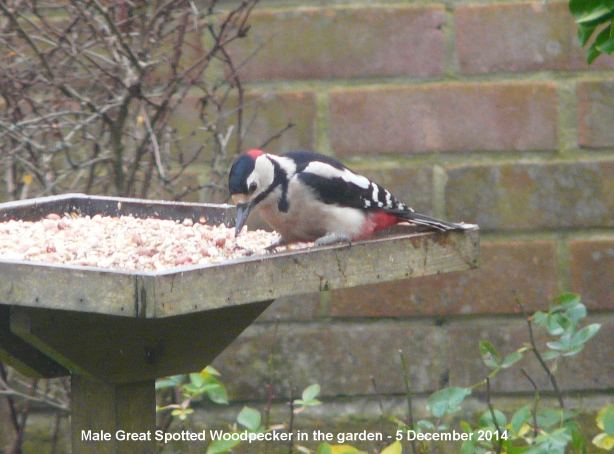
The female prefers to peck away at the fat balls as usual.
MONDAY NOVEMBER 25 - 2013House Sparrows return
A couple of weeks ago I invested in some new feeders for the garden and some different 'No more mess' bird seed which I thought I would try as a possible alternative to sunflower hearts. Well, the Goldfinches have not touched the new seeds, they have stayed loyal to the sunflower hearts, but House Sparrows seem to love them! This morning there were 12 on the feeders, which is the most I have seen in the garden since May 2007. I don't think this indicates a sudden resurgence in the House Sparrow population, but rather the discovery by this group of some food to their liking in my garden.
Here are a couple of sparrows on one of the new feeders
THURSDAY OCTOBER 10 - 2013COLLARED DOVE GARDEN DECLINE
Keith Betton reported on Hoslist a decline in Collared Doves in his garden (from up to 10, down to maybe just 2), and noted a couple of similar comments in the Hampshire Bird Report. Keith noted also that results just in from the BTO's Garden BirdWatch show that the Collared Dove has declined by a quarter in gardens in the last decade. One reason for this could be the increasing Woodpigeon numbers - the two birds perhaps competing for similar food and habitat. However it is thought that Collared Doves could be more susceptible to the illness trichomonosis than Woodpigeons and that the rise in disease incidents might be having an effect on the Collared Dove population. Keith also noted that Sparrowhawks killed at least four Collared Doves in his garden in the last three years. He asked what others have experienced.
My own experience since I started the GardenBirdwatch recording in my present urban garden in the village of Emsworth in 1997 mirrors that reported by Keith and the BTO. After a steady increase from a weekly mean of 1.9 in 1997 to a peak of 8.2 in 2008 with a constant 100% presence, the weekly mean plummeted to 3.4 in 2009 and was only 2.2 in 2012, with only around 80-90% presence. However, there does appear to be signs of a recovery this year with a weekly mean of 3.9 and a 100% appearance.
Keith mentions Woodpigeons as a possible reason for the decline. In my garden (as in the Garden BirdWatch generally) Woodpigeons have increased over the past 15 years with the weekly mean steadily rising from 0.3 in 1998 to 2.1 in 2008 after which it stabilized. But I have not seen any obvious signs of the two species competing for food that I put out for the birds.
I did not realise that Collared Doves were subject to the illness trichomonosis which has so devastated the Greenfinch population since 2006. But that could be a factor certainly as the decline in Collared Doves began two years later in 2008. Interestingly, Chaffinches. which also suffered from trichomonosis, declined in my garden at the same time as the Collared Doves, down from a weekly mean of 5.5 in 2008 to 2.5 the following year. And, like Collared Doves, Chaffinches are showing signs of recovery this year - up to weekly mean of 4.5 so far.
As for Sparrowhawk attacks, I only recall seeing one pile of feathers, probably from Collared Dove in the garden over the past year. I do not see this as a likely cause.
MONDAY APRIL 29 - 2013I had a pure white dove in the garden again today. This is one of several I see frequently around St James Church and probably live in a local dovecot.
FRIDAY MARCH 8 - 2013Stock Dove in garden
We had an unusual visitor to the garden this afternoon in the shape of a Stock Dove. It remained in the garden for about 10 minutes feeding with three Woodpigeons. I took some photos through the window which show the main features of the bird; a green iridescence around the neck (but no collar), two black bands on the wings, dark gentle-looking eyes and a pink yellow tipped bill.
I often hear Stock Dove singing its 'ooo-wu' song in the Brook Meadow area and elsewhere. However, my only other sighting of Stock Dove in my garden was in 2009 when I had two sightings, the first on Jan 19 and the second on May 1. The BTO does not publish data for Stock Dove in the Garden BirdWatch scheme, though I suspect the frequency is fairly low in gardens.
Generally, following release from the lethal and sublethal effects of the organochlorine seed-dressings used in the 1950s and early 1960s, Stock Dove populations increased very substantially, but then levelled off in the early 1980s, and entered a further increasing phase in the early 1990s. Recent indices suggest that numbers have fallen significantly in the last few years.
MONDAY JANUARY 21 - 2013My small garden in the centre of Emsworth was simply teeming with birds today, quite an astonishing sight at times. I logged of 14 species and a total of 58 birds. As the weather continues to be very cold and snow is still lying on the ground and bushes, food must be hard to find. It surprises me that so may birds manage to survive the night temperatures.
Chaffinches galore
Chaffinches were always present whenever I happened to be looking out of the window, either on the ground, under the shrubs or on the bird table. Otherwise they would fly up into a neighbour's Silver Birch tree. They were not easy to count, but my best estimate would be 30, which is a record for my garden, beating the 28 in years 2008 and 2003.
Brambling
In with the Chaffinch flock was a single Brambling, unmistakable with its white belly contrasting with its bright orange chest and shoulders. I had my first garden Brambling in Dec 2010, then in Jan 2011, I had up to two birds 4 weeks running. This was the first of this winter.
Blackcaps
After writing in yesterday's blog that I had only seen a female Blackcap in the garden this winter, well, as so often happens, I also had a male in the garden. I saw the female several times today, always feeding on the apples I had pinned to the tree. The male Blackcap, in contrast, seemed very nervous. It made a couple of visits to the bird table which had mixed seed and chopped peanuts on it, but flew off each time when it spotted movement behind the window. On one occasion, I noticed the female Blackcap chasing off the male Blackcap, though as I have said before I have never seen any aggression towards other species.
Other garden birds
Other birds of special interest for me were 2 Greenfinches, a Coal Tit and a Starling, all fairly scarce birds in my garden. The Starling stayed for some while in the tree looking down at the bird table stocked with food, but never bucked up enough courage to come down. They really need safety in numbers.
I saw no sign of the Redwing or Fieldfare that I had briefly last week, even though there seems to be a wave of them passing through our area at present on the hunt for food.
FRIDAY JANUARY 18 - 2013Snowfall
In common with other areas of the south coast, we experienced a fairly heavy snowfall today. It began in Emsworth in the early morning and got heavier. It eased of for a while, then started again and carried on until late afternoon. I measured a final depth of 4 1/4 inches (11cm) on our flat patio table, far less than the 7 inches I recorded after the last heavy snowfall we had in early Dec 2010. Here is a photo of my garden during the snowfall.
Garden birdsI spent much of the morning watching the birds in the garden. There was much coming and going of most of the regular garden visitors, including an unusually large number of 18 Chaffinches. I also had 2 Greenfinches and a female Blackcap. I kept replenishing the feeding areas that remained fairly free of snow beneath the bushes with mixed seed and chopped peanuts.
It is good to see a Greenfinch back on the feeders
A female Blackcap has been a regular visitor to the garden this winter
At about 11am I saw a flock of about 30 Redwing fly in to perch at the top of the Silver Birch tree in next door's garden. I recall seeing a similar number in this tree during the snowfall in Feb 2012. They only stayed for about 30 seconds and there was no chance of a photos. However, I did manage to get a digiscoped photo through the window and the snow of a single Fieldfare that arrived in another neighbour's tall tree with a flock of Starlings.
MONDAY 14 JANUARY 2013Snowfall in the garden
Just a quick shot of the snow falling on my garden this morning. It did not last.
Garden GoldcrestI had a yet another Goldcrest in my garden near the centre of Emsworth today. This was the 4th week running I have recorded this bird, which previously has been a very rare visitor. Here is my photo through the window in light rain. Nice to compare with Malcolm's Firecrest above ie no white supercilium on the Goldcrest.
FRIDAY DECEMBER 14 - 2012GARDEN BIRDS
Little Egret
A nasty wet morning, so I sat in front of the window watching the birds in my back garden. The best surprise was the appearance of a Little Egret on the back fence which overlooks the Westbrook Stream. Here is my best shot through a misty window. It tends to walk along the fence looking down for fish.
Little Egret is a fairly regular visitor to my garden in winter, though this was the first time I had seen it this year since early February. Little Egret is not one of the 41 core species in the BTO Garden BirdWatch Scheme, so I do not have data on the overall reporting rate, but I suspect it is quite low.
Blackcap
A female Blackcap was a welcome visitor for the second time this week. Patrick Murphy has also had a female Blackcap in his garden last week, while lucky Caroline French had two males and a female in her garden at the same time.
These Blackcaps will be winter visitors from the Continent and they regularly come into gardens to supplement their food supply. About 11% of people taking part in the BTO Garden BirdWatch report Blackcap in the winter period. Sightings are scattered around the country, but most tend to be concentrated in the South of England.
The following chart shows the reporting rate for Blackcaps throughout the year. The rate increases in late October when the first of the wintering birds arrive and peaks in February. The rate then declines sharply through March and April as the wintering birds leave. The rate continues at a steady level through the summer period when the summer visitors are present.
If you get regular Blackcaps in your garden you might interested in taking part in the BTO Garden Blackcap Survey. See the following link for details, but note it does not start until January 2013 . . http://www.bto.org/volunteer-surveys/gbw/about/background/projects/garden_blackcap_survey
MONDAY DECEMBER 3 - 2012Magpies in garden
I have previously written (on Nov 30) about having a Magpie in the garden trying to grab the fat that I had rubbed into the bark of a cherry tree. Well, what I assume is the same bird has been coming daily since then and today I managed to get a photo of it in action. After a couple of minutes it was joined by a second Magpie and so I had the pleasure of seeing two in my garden for the first time ever.
FRIDAY NOVEMBER 30 - 2012Magpie in garden
After about 7 months without seeing a Magpie in my garden, one now seems to have taken up residence. I first saw it a few days ago when it was trying to get some fat that I had rubbed into the bark of the cherry tree. This was hard work and it had little success. Now, it has discovered the bird table on which I provide a liberal supply of seed and chopped peanuts. It is a nice smart bird, but appears very nervous and aware of me when I move around behind the window. Most other birds take no notice of my moving. However, I managed to get this photo through the window without disturbing it.
In view of its scarcity in my garden I was surprised to find that Magpie stands at number 10 on the all Britain list of garden birds for this quarter of the year and is even higher at number 6 on lists for the southern areas. About half of participants in the BTO Garden BirdWatch scheme report Magpies in the garden, with peaks in winter and the nesting season. There is a low point in September when many birds forage on farmland.
THURSDAY NOVEMBER 29 - 2012Starling
I had a Starling in the garden today. They are now very rare visitors to the garden, but they used to be very common. This is clearly shown by the following chart which plots the mean weekly count since 1998.
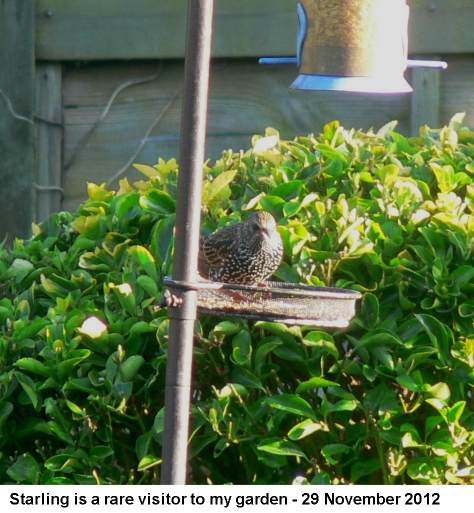
Greenfinch
I also had a Greenfinch feeding on the sunflower hearts. This is another bird that used to be very common, in fact my number one garden bird for many years, but is now only an occasional visitor. Their numbers were badly affected by the disease trichomonosis.
Woodpigeon
Woodpigeon is a bird which has gone the other way and become far more frequent in the garden than it used to be. Several are now daily visitors to the garden, including this juvenile Woodpigeon which prefers feeding on the bird table to the ground. The juvenile differs from the adult by having dark eyes and no white collar. It differs from the similar Stock Dove by its white wing flash and longer tail which extends well beyond the wing tips at rest.
SATURDAY NOVEMBER 10 - 2012Winter Blackcap
We had our first 'winter' Blackcap in the garden today. A female with her distinctive brown cap was first seen feeding in the Buddleja bush. Then she dropped down to have a bathe in the plastic tray which passes for a bird bath.
Blackcaps which winter in this country are generally considered to be a different population from the summer migrants from the Mediterranean. Ringing studies have established that Blackcaps regularly migrate from The Continent to spend the winter in this country, often visiting gardens.
Wintering Blackcaps are not uncommon in my garden; I have recorded them in most of the 15 years I have been in my present house in Bridge Road, both males and females. In fact, this year, for the first time I had a pair visiting the garden in June which must have been summer migrants. Today's sighting takes to 14 the number of species recorded in my garden this week, which is a very good tally.
WEDNESDAY NOVEMBER 7 - 2012Birds return
After several weeks with very few birds in the garden, the cold weather has finally prompted a return. Over the past two weeks I have recorded 15 species. Most are regular daily visitors - Goldfinches (up to 10), Woodpigeons (up to 6), Chaffinch (up to 3), Greenfinch (up to 4), Collared Dove (up to 4). Others are occasional, not daily, like Blackbird, Blue Tit, Dunnock, Great Tit, House Sparrow, Robin. I have also had brief visits from Coal Tit, Long-tailed Tit (about 20 came through one day), Great Spotted Woodpecker (female) and Starling (now a great rarity). The Grey Squirrel is now a regular visitor to the garden for the first time in 15 years. It comes and goes frequently during the day.
GoldcrestsWhen I came down for the first time this morning, three Goldcrests were flitting around the shrubs outside the back window. They were constantly on the move and did not stay long, but I grabbed my camera nd managed to get a few snaps through the window. This was the best I could get.
Goldcrests are very rare in my garden, usually not more than one or two sightings each year. The last one was in December 2011 and before that February 2009. Interesting to hear that Tony Wootton also had Goldcrests on Brook Meadow today. Not the same ones surely?
Goldcrest is ranked 25th in the BTO garden bird list for this quarter of the year in the south-eastern area, having been reported in about 7% of gardens. http://blx1.bto.org/gbw-dailyresults/results/gbwrt2012-53-7.html
Garden squirrel - 16 October 2012A Grey Squirrel spent virtually the whole afternoon collecting peanuts, which I had only recently put on the feeding station and bird table, and not eating them, but burying them around the garden. This is the first time I have witnessed this common behaviour in my garden.
BTO GARDEN BIRD NEWS - 27 September 2012Woodpigeon soars
BTO reports Woodpigeons are visiting a record number of gardens this year. During a typical week, 87 per cent of British and Irish householders have reported this species in their garden. The figures for Woodpigeons now exceed figures for Robins (83 per cent) and Great Tits (78 per cent). Only Blue Tits (90 per cent) and Blackbirds (95 per cent) now stand in the way of woodpigeons reaching the number 1 spot.
In some areas, including Hertfordshire, Nottinghamshire, Warwickshire, West Midlands and West Sussex, there are strong indications that woodpigeons are already the leading garden visitor.
My Woodpigeon records
Woodpigeon has also become far more frequent in my present garden since1998. However, the big increase was between 1998 (25%) and 2007 (80%). As shown in the following chart, since then the frequency has been fairly stable. In 2011 Woodpigeon was my number 3 garden bird in terms of the percentage of weeks recorded (73%), exceeded only by Goldfinch (90%) and Collared Dove (78%).
Bullfinches - 6 June 2012This afternoon at about 3pm we had a male-female pair of Bullfinches on the feeding station and the bird table for abouit 10 minutes. This gave me the chance to take a few photos through the window. They were the first Bullfinches seen in the garden since July 2008.
Jay in the garden 31 May 2012Just after I got up at around 8am, I noticed a beautiful Jay on the grass in the back garden. It went onto the seed tray on the bird feeding station where it remained feeding on the chopped peanuts and seeds for a few minutes. This gave me time to get my camera out and take a few snaps through the window. This was the first ever Jay I have seen in the garden since we moved in to the present house in 1997.
It flew off across the gardens going eastwards. Jay is a fairly common bird in the Lumley area of Emsworth and is sometimes seen crossing Brook Meadow. This bird was probably from that area, prospecting the garden feeders.
Jay is not a common garden bird. At present it is ranked 27th on the BTO GardenBirdWatch list with 11% of gardens reporting it. It is more likely to be seen in the breeding season in June with another peak in winter (Nov-Jan).
2 OCTOBER 2011Chiffchaff
I have had this Chiffchaff calling from the Silver Birch tree on several days this week. It was at it again this afternoon and I managed to get a sighting of it. I am fairly sure it was Chiffchaff from its monosyllabic whistle, in contrast to the disyllabic call of Willow Warbler. It was feeding actively in the tree, moving quickly from one twig to another. Typically, it stays for about 5 minutes then departs not to be heard again until the following day, provided I was in the garden to hear it. This is the same tree that I had a Willow Warbler in on 4 April 2010. I managed to get a reasonable photo of it, but I identified it from its song.
RECENT NEWS AND SIGHTINGSCOLLARED DOVES IN DECLINE? - 6 July 2011
The most recent BTO Garden BirdWatch magazine (Summer 2011) highlights an unexpected decline of the Collared Dove as a garden bird over the past 7 years. The mean garden weekly reporting rate of Collared Doves was relatively stable from 1995 to 2004, after which a small but steady decline has occurred. Figures for the winter quarter January-March 2011 indicate Collared Dove is now found in only 64% of gardens, the average rate over the past 15 years being 74%.
The Common Bird Censis and the Breeding Birds Survey show a similar trend with an increase in Collared Dove sightings up to about 2005 followed by a steady decline. Just what has caused this decline is a mystery. Or maybe it is just a temporary blip.
Figures from my own garden show a steady increase in mean weekly counts from 1997 to 2008 followed by a dramatic fall since then. The mean weekly count rose from 1.9 in 1997 (when I first moved in) to 8.2 in 2008 and then plumetted in the last two years to 3.4 in 2009 and 3.3 in 2010. This was despite a maximum of 33 in one week in January 2009 and 16 in February 2010. This year's figures seem to continue this trend.
The initial spread of Collared Doves across the United Kingdom was very rapid. From the first breeding report (in Norfolk in 1955) the species was subsequently reported breeding in Kent and Lincolnshire in 1957, with birds seen as far north as Scotland at this stage. Two years later Ireland was colonised and by 1970 there may have been as many as 25,000 pairs in Britain and Ireland. The BTO Common Birds Census revealed a five-fold increase in their population between 1972 and 1996.
We had 28 Collared Doves in the garden in December 2008. The record is 46 in 2004.
WOODPIGEONS ARE ON THE UP - 25 June 2011Woodpigeons are on the increase in gardens as shown by the Garden BirdWatch scheme and they are most prevalent in June and July. Despite their numbers increasing across the board, the southerly and easterly bias of Woodpigeon populations means that counts are much higher in English gardens than elsewhere. Indeed, in England, only Blue Tits and Blackbirds are spotted more frequently, with Woodpigeons even surpassing one or other of these in London, Eastern England and the East Midlands. BTO argue, if they continue their current rate of increase in gardens, Woodpigeons will be seen more often than any other species in English gardens by 2013.
My own garden records also show a steady increase in Woodpigeon frequency over the years as shown in the following chart. The chart shows the mean weekly count over the year. They are currently stand third in the ranking in my garden after Blackbird and Collared Dove. Ten years ago they were 10th in popularity.
In the coming months, young Woodpigeons will be about, which lack the white collar of adults and also have a greyish colour to their eyes and beak.
The BTO Breeding Bird Survey (BBS) reveals that Woodpigeons are also on the up across all habitats. The trend for this species is of a steady, steep increase since at least the mid 1970s. The spread of intensive arable cultivation, especially of oilseed rape, which has been shown to promote overwinter survival, may explain the rise in numbers. Woodpigeon numbers have also risen rapidly across Europe since 1980.
ALBINO COLLARED DOVE? - 12 April 2011I had a very pale Collared Dove in the garden. It was feeding on the grass with other normally coloured Collared Doves. I have never seen one like this before. A search on the internet indicates albino Collared Doves are quite scarce.
TWO BRAMBLINGS IN GARDEN - 9 February 2011A Brambling has been a regular in the garden over the past few weeks, coming in with a flock of Chaffinches. However, today there were two Bramblings. Got a nice photo of them on the bird table, eating seeds and chopped peanuts. This is the second time this winter I have seen in the garden. Last seen on Jan 31.
BRAMBLING IN GARDEN - 18 December 2010Dec 18 - 2010 - Overnight snow brought birds flooding into the garden. Goldfinches were the mainstay as usual, with up to 15 on and around the feeders at any one time. A flock of around 20 Chaffinches were frequent visitors, feeding on seeds scattered on the snowy ground. I spotted one female Brambling among them with a distinctive white belly contrasting with orange chest and shoulders. This was a first for the garden. A less welcome sight was a Chaffinch with a badly deformed foot. Another newcomer for this week was a female Blackcap feeding on moistened bread on the bird table.
Jan 31 - 2011 - One Brambling has become a regular visitor to the garden. But today, there were two standing out clearly from the dozen or so Chaffinches. One of them returned later where it nibbled food on the bird table, giving me an opportunity for a photo. Both birds were equally bright orange which suggests they were males? My theory is that Bramblings latch onto a flock of more street-wise Chaffinches which lead them around the good local feeding spots, including gardens, like mine!
BIRDS WITH SNOWFALL - 2 December 2010I spent a good deal of time today, sitting in the warm, watching birds swarming to the food I put out for them in the back garden. It was a real bonanza, not seen for several years. Goldfinches were ever present on the four sunflower heart feeders, which I needed to replenish a couple of times. Generally, there were about 15 of them jostling for space on the perches, but I counted 30 when they all perched in a nearby Silver Birch tree. The Goldfinches also spent much time prising seeds from the tiny cones of a neighbour's Leyandii type tree.
Other birds on the feeders included up to 12 Blue Tits, 1 Great Tit, 1 House Sparrow and 3 Greenfinches.
About 14 Chaffinches were also ever present, often stationed beneath the feeders, mopping up bits of seed dropped by the Goldfinches. Other gathers of bits dropped by the Goldfinches included a Robin and a Dunnock.
Hundreds of Starlings spent the day flying around the area in a great flock, up to 20 descending onto the bird table from time to time, to feed feverishly, and the whoosh, off they went.
Black-headed Gulls were also flying around for much of the day, and quickly spotted the moistened bread that I put out on the bird table. I had eight of them on the small table at one point, the most I have ever seen in the garden. The bread, needless to say, did not last long.
Up to 4 Blackbirds spent a good time rushing around and taking food from the bird table. No sign of any Song Thrush.
A Pied Wagtail, a rare garden bird, flitted around briefly and was not seen again.
Collared Doves and Woodpigeons were unusually reticent, though one fat Woodpigeon did spend some time scoffing raisins that I thought might be a treat for the smaller birds.
REDSTART IN GARDEN - Monday 4 October 2010We had a handsome male Redstart in the garden at least twice today, once at about 9.30am and again at 2pm. It did not stop long enough for a photo, but it afforded clear views on both occasions with its striking black face, orange breast and constantly quivering orange tail.
This was the first time I have ever seen a Redstart in my garden, in fact, the first one I have seen anywhere or a couple of years. It gets no mention in the BTO GardenBirdwatch scheme. Mike Cocker (in his book 'Birds in the garden') says Redstart will breed in our near wooded gardens and elsewhere may pay a fleeting visit on migration. This is clearly what happened in this case, a breeding bird on its way south to wintering grounds in tropical Africa.
BLACKCAPS - Sunday 14 November 2010The weather was rotten, and I was nursing a nasty chest cold, so this gave me the opportunity to spend some time watching the birds in the garden. It always pays off. Garden birds have been extremely scarce over the past few months, at least until last week. Well, during a couple of hours this morning I logged 13 different species, the best by far since early June.
The best birds were a male and female pair of Blackcaps which visited the garden on at least two occasions. This is a reminder to hang some apples up. These birds will almost certainly be wintering migrants from the continent and not late summer migrants. I get a few sightings of the each year, usually during spring and autumn, or during exceptionally cold weather. The last I saw in the garden were in April this year.
Today's birds were in a dense bush and I was not able to get a decent photo of them, but saw them clearly. Here is a photo I took of a male Blackcap in January last year.
STOCK DOVE - Friday 1 May 2009I was surprised to see a Stock Dove in the garden at about 7pm this evening. The light was not good, but I took a few photos. This is only the second time I have ever seen a Stock Dove in the garden, the first being earlier this year on 19-Jan-09. I think it comes over from St James Churchyard where I often see and hear one. The church is only about 200 yards or so away "as the crow flies".
GREAT SPOTTED WOODPECKER - SUNDAY 3 AUGUST 2008Jean and I had a very nice surprise as we were sitting having a cup of coffee in our back room overlooking the garden when a male Great Spotted Woodpecker appeared on the flowering cherry tree. It remained in the garden for about 10 minutes allowing me plenty of time to take some photos through the window. It spent most of the time pecking the trunk of the tree, presumably after insects and occasionally perching, rather ungainly, on one of the sunflower seedholders hangin from the branches of the tree. It would no doubt have preferred a peanut holder, but I have long since removed them from the garden, as they were not used by the birds. This was only the second time I have seen a Great Spotted Woodpecker in the garden of my present house in Bridge Road, though they were regular visitors to the garden of my previous house in Westbourne Avenue. The last sighting was on 22 November 2005.
PHEASANT - SATURDAY 15 MARCH 2008
A handsome male Pheasant was in my back garden for most of the morning. This was the first ever sighting of one in the garden. I first saw it at about 10am perched on the wall at the end of the garden. Later it plucked up courage to come down onto the grass to feed on the seeds where it remained for the next 3 hours! Amazing to think it turned up in the middle of town.
BULLFINCH - THURSDAY 10 JULY 2008
As I was having my lunch I happened to look out of the window and, to my astonishment, saw a handsome male Bullfinch on the sunflower heart feeder. It stayed long enough for me to get out my camera and get a few snaps through the window before it disappeared, not to return. This was only the second Bullfinch sighting I have had in the garden, the last one being almost 10 years ago, on 1 January 1999 when I saw a male taking the buds from a forsythia bush at the bottom of the garden.
GOLDCREST - a rare visitor
Song Thrush - common in winter
SPIDER CATCHES SPECKLED WOOD
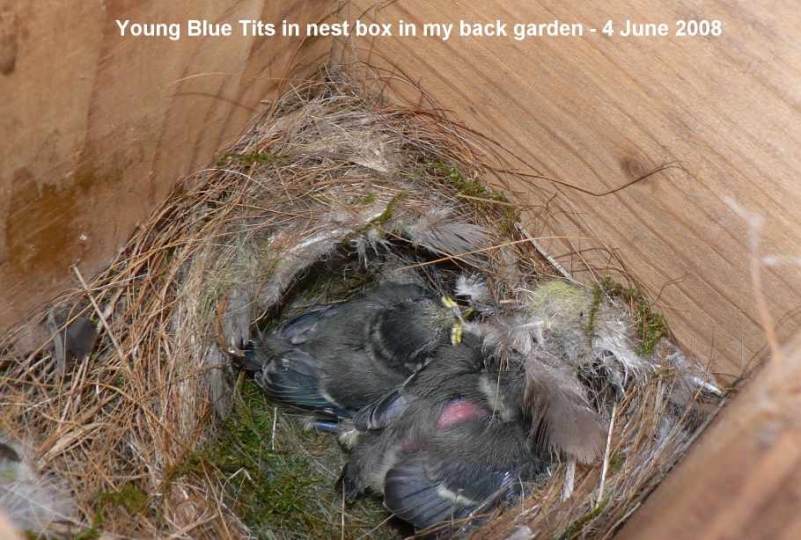
SPARROWHAWK - 31 July 2005 -
We had a most exciting event in the garden this morning. At about 11am a Sparrowhawk swooped in, took a House Sparrow from the bird table and spent the next 40 minutes or so on the ground with the Sparrow trapped under its talons. First, the Sparrowhawk plucked all the feathers off its victim and then proceeded to tear off pieces of flesh and consume them. Only the beak were plucked off the Sparrow, then the Sparrowhawk tore off pieces of flesh and bone to consume them. Finally, the Sparrowhawk used some of the feathers as a napkin, to clean off its beak. Nothing was left on the ground but for the House Sparrow's beak and a pile of feathers. All very smart and efficient. Although I have seen a Sparrowhawk in the garden on several other occasions, this was the first time I have seen it actually take a bird and consume it before my eyes. I was able to take a number of photographs and videos of the whole event through the garden window. From its barred dark brown upperparts and relatively small size I assume this was a juvenile male Sparrowhawk.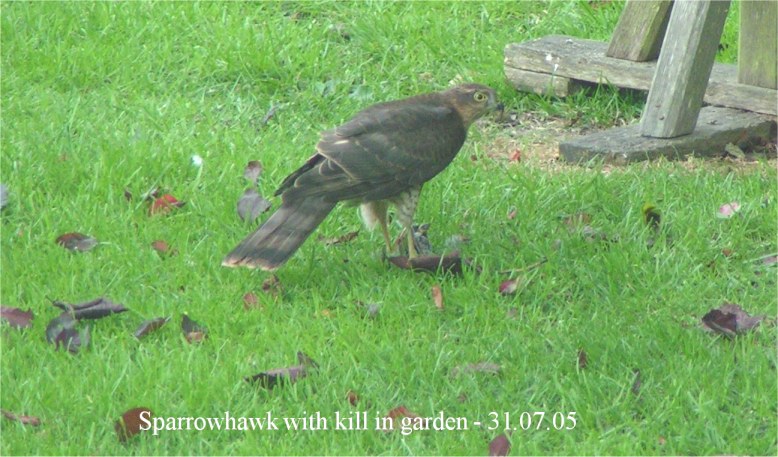
SWIFTS - FRIDAY 15 JULY 2005 -
It was a very warm evening and I have just spent the last 30 minutes or so in my back garden watching the Swifts flying in the sky, a magnificient spectacle. Mainly, they tend to feed high in the sky, sweeping and twisting to catch insects. However, occasionally they come together in small or large groups up to 40 and sweep screaming through the air in tight formations. This, I gather, is all to do with social bonding, but I would call it sheer fun and enjoyment.
TURTLE DOVE - THURSDAY 30 JUNE 2005 -
I was amazed to find a Turtle Dove feeding with the regular half dozen or so Collared Doves on the lawn in my back garden at about 8am this morning. This is a lifetime garden first for me. Fortunately, the bird stayed around for another 5 minutes or so after the Collareds had flown giving me time to get my camera out for a few snaps and a video, albeit through the window. I saw it again at about 11am, this time on its own. It returned this evening at about 7pm and stayed feeding on the grass for about 45 minutes. How exciting!
The Turtle Dove returned to the garden to feed on seeds which I scatter onto the grass for the following 4 days after which I did not see it again.
KINGFISHER - MONDAY 14 MARCH 2005
Great excitement this morning as a Kingfisher perched on the end wall overlooking the Westbrook Stream for fully 30 seconds. Not enough time to get the camera set up, but a fine sight and a first for the garden. The Kingfisher returned again on Thursday March 18. A Kingfisher on the back wall overlooking the stream became more common over the next few years.
